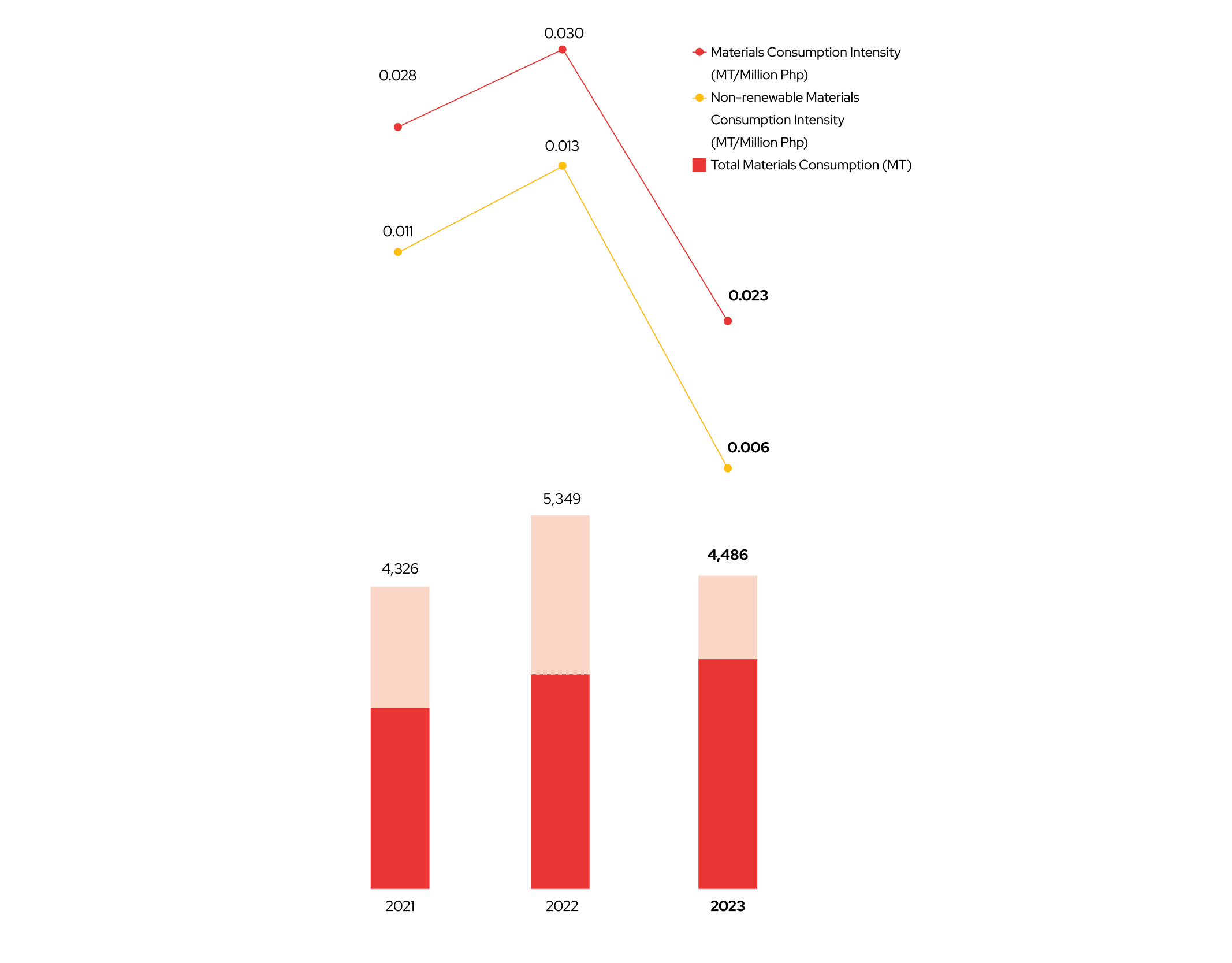
Business Review
Robinsons Retail achieved Php192.1 billion in net sales in 2023, a notable increase of 7.4% supported by blended same store sales growth (SSSG) of 3.9% and store expansion initiatives. Despite the impact of inflation on consumption and a challenging base in 2022 which benefitted from economic reopening and election-related spending, the company continued to demonstrate resilience. The primary drivers of revenue growth were the core staples businesses, namely supermarkets and drugstores, which collectively accounted for over 70% of revenues.
Gross profit rose by 7.8% to Php45.6 billion in 2023, outpacing
revenue growth. This was propelled by assortment shifts and the
sustained penetration of private label brands. Operating income
also experienced moderate growth, rising by 2.8% year-on-year to
Php8.9 billion.
Net income attributable to equity holders of the parent company
however decreased from Php5.8 billion in 2022 to Php4.1 billion
in 2023. The decline was due to the reversal of foreign exchange
gains in 2022 to a loss in 2023 due to the appreciation of the
peso against the US dollar, the derecognition of Robinsons
Bank’s net income under equitized earnings following its merger
with BPI, and losses from start-up investments. Meanwhile, core
net earnings, which exclude foreign exchange gains/losses,
interest income from bonds, equity in earnings from associates,
interest expense related to the BPI shares acquisition
financing, BPI cash dividends, and other one-time or
non-operating items, exhibited marginal growth of 1.5% to Php5.6
billion.
Throughout the year, Robinsons Retail expanded its footprint by
adding 84 new stores, predominantly in the Supermarket and
Drugstore segments. This brought the total number of stores to
2,393, comprising 349 supermarkets, 1,054 drugstores, 50
department stores, 230 DIY stores, 408 convenience stores, and
302 specialty stores. Additionally, the company operates 2,127
franchised stores of TGP. The assortment of specialty stores
includes 119 appliances & electronics stores, 42 toys
stores, 118 mass merchandise stores, 11 beauty stores, 10 pet
stores, and 2 lifestyle sneakers stores.
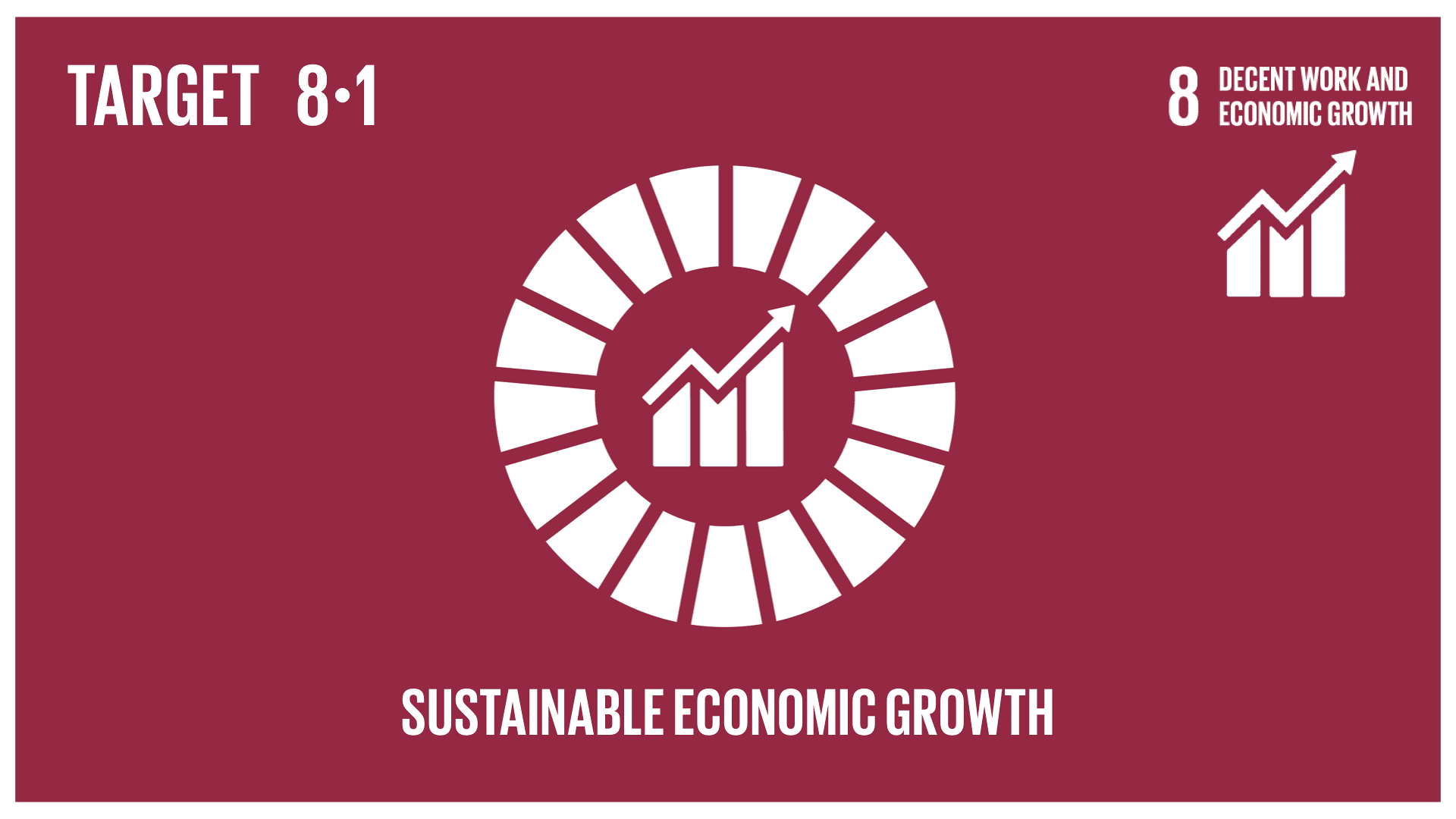
Contributing to Shared Growth:
Direct Economic Value Generated and Distributed
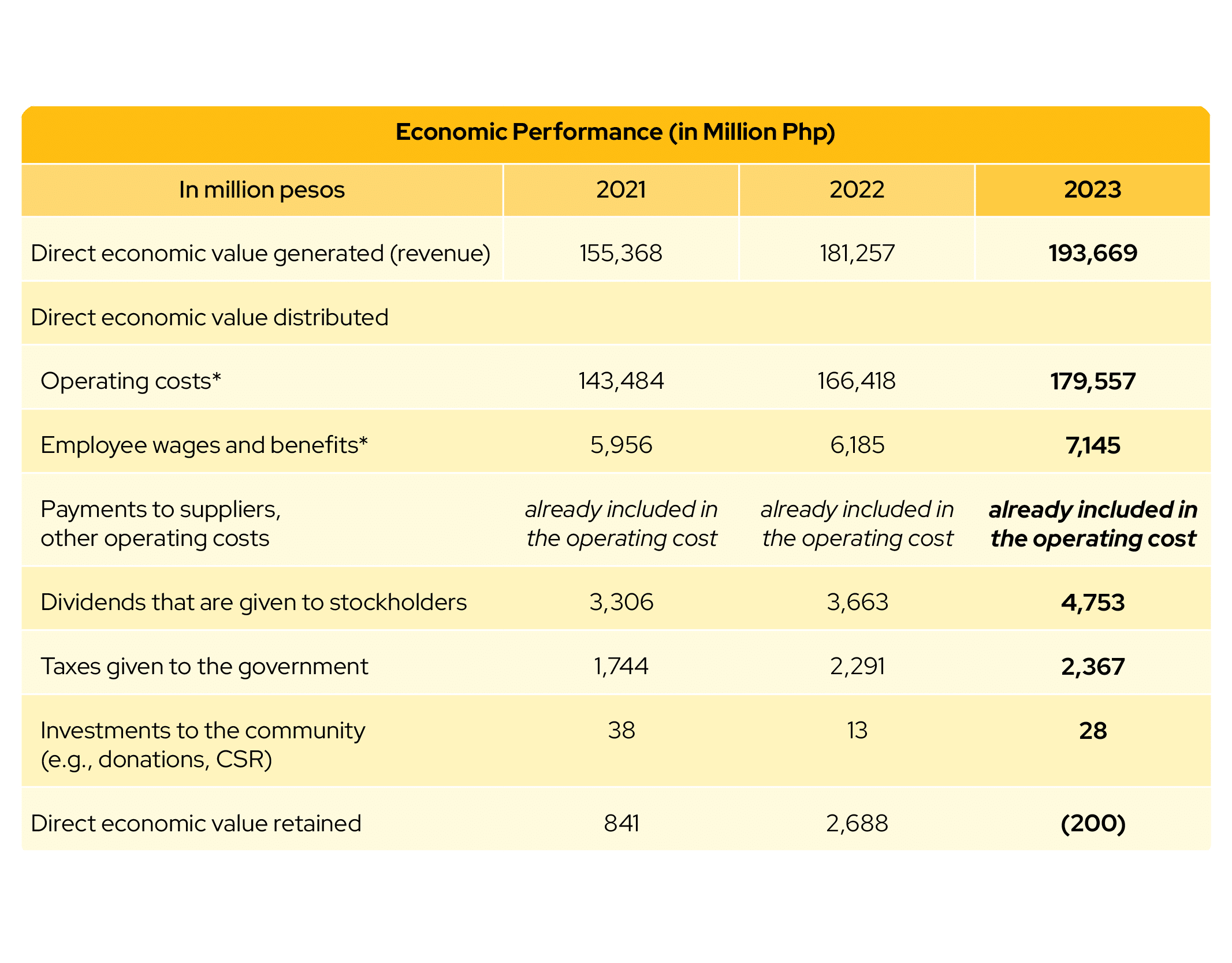
* Restated 2021 and 2022 values due to the original inclusion of third-party manpower wages in the employee wages and benefits.
At Robinsons Retail, we aim to create long-term value and shared
successes within the communities we operate in. Through our
operations and supply chain, we are able to impact local
economies by generating employment and nurturing a robust
network of partners and suppliers from various entrepreneurial
backgrounds.
To ensure a healthy financial standing and sustained resilience,
we maintain rigorous business continuity plans to protect our
assets and have a dedicated Enterprise Risk Management Team,
overseen by our Board of Directors.
We continue to implement our Share Buy Back Program worth Php7.0
billion to increase shareholder value and optimize returns for
our investors. Our annual cash dividend of Php 2.00 per share in
2023 equates to a payout ratio of 50%, above our 40% dividend
policy.
Looking forward, we are focused on expanding our presence in
underserved areas, strengthening our omnichannel strategy, and
pursuing strategic acquisitions to drive growth. Additionally,
we are committed to operational efficiency, sustainability, and
data-driven decision-making, ensuring that we continue to
deliver value to all stakeholders while navigating the evolving
business landscape with resilience and foresight.
Thriving in Tandem
On January 1, 2024, the merger between BPI and Robinsons Bank
was finalized, with BPI emerging as the surviving entity.
Robinsons Retail now effectively owns 6.5% of BPI and is
entitled to a board seat in the bank.
Robinsons Bank has played a pivotal role in helping our key
suppliers grow through the financial products and services that
it has offered, and this is expected to grow even more with the
facilities now accessible through BPI, helping them enhance
their operational capabilities and service offerings. This
ripple effect cascades throughout our supply chain, resulting to
improved efficiency, reliability, and ultimately, enhanced
customer satisfaction.
Omnichannel is Now
Our digital investments remain vital as we continue to expand
our digital footprint to accelerate our omnichannel strategy.
We maintain a 14% stake in Growsari, a technology-driven B2B
platform serving over 1 million sari-sari stores across the
Philippines, with products sourced from Robinsons Supermarket.
Growsari’s monthly active store users continue to increase, all
serviced via 23 distribution centers.
Now with close to 3 million customers in merely 14 months since
it began commercial operations, GoTyme continues to make waves
in the digital banking space. We currently have a 20% stake the
digital bank, which now has close to 400 bank kiosks located at
our stores. We continue to be able to onboard more customers on
GoTyme, which allows them to receive a debit card within minutes
but also conveniently cash-in and cash-out for free across our
stores and earn Go Rewards points every time they use their
cards. As GoTyme continues to accelerate, has also helped
accelerate the growth of our Go Rewards customer base, which now
has more than 8 million members.
Our 23% stake in O!Save, a hard discount supermarket chain
established in 2021, also continues to yield promising results
as it continues to expand across the country. This collaboration
enables us to tap into the growing hard discount supermarket
segment, while enabling O!Save to tap into the expertise and
resources of an established retail player like us.
Finally, GoCart, our in-house e-commerce platform dedicated to
our formats, remains essential to realizing our omnichannel
push. GoCart continues to allow us to bridge the gap between our
physical stores and our online footprint, offering customers
convenience and flexibility in their shopping journey.


Our People
Diversity Drives Innovation
At Robinsons Retail, diversity is our strength. Each member of
our team brings a unique set of skills, perspectives, and
experiences to the table, enriching our approach to business and
driving innovation forward. We understand that fostering an
inclusive workplace is not just the right thing to do – it is
essential for our success.
Our hiring and onboarding process are designed to be objective
and non-gendered, ensuring that we attract and retain a diverse
pool of talent. We are committed to creating environments where
everyone, regardless of gender, feels valued and empowered to
contribute their best work.
At Robinsons Retail, women are at the helm, steering our
Company’s success across all facets of management. Currently,
women comprise 70.5% of our workforce, occupying key positions,
including our President and CEO, Chief Financial and Chief Risk
Officer, Treasurer, Corporate Secretary, and Head of Corporate
Planning, Investor Relations, and Sustainability. Additionally,
65.9% and 66.1% of women employees hold managerial and
supervisory roles, respectively.
Our efforts in championing our employees resulted in our
re-inclusion in the Philippine Daily Inquirer and Statista’s
list of the Philippines’ Best Employers, together with our
subsidiaries, Robinsons Supermarket, Robinsons Appliances, Rose
Pharmacy, and South Star Drug.
2023 Demographics
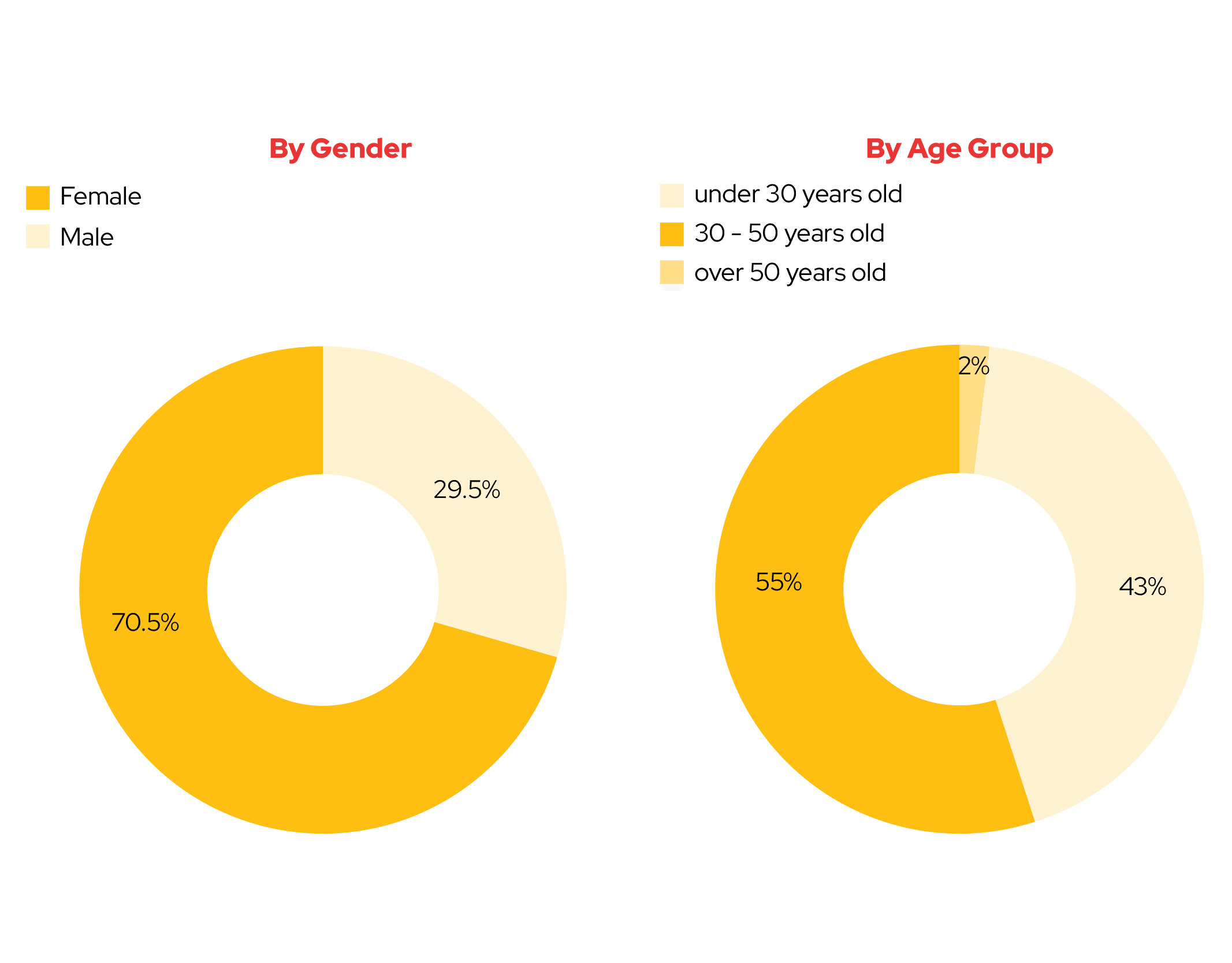
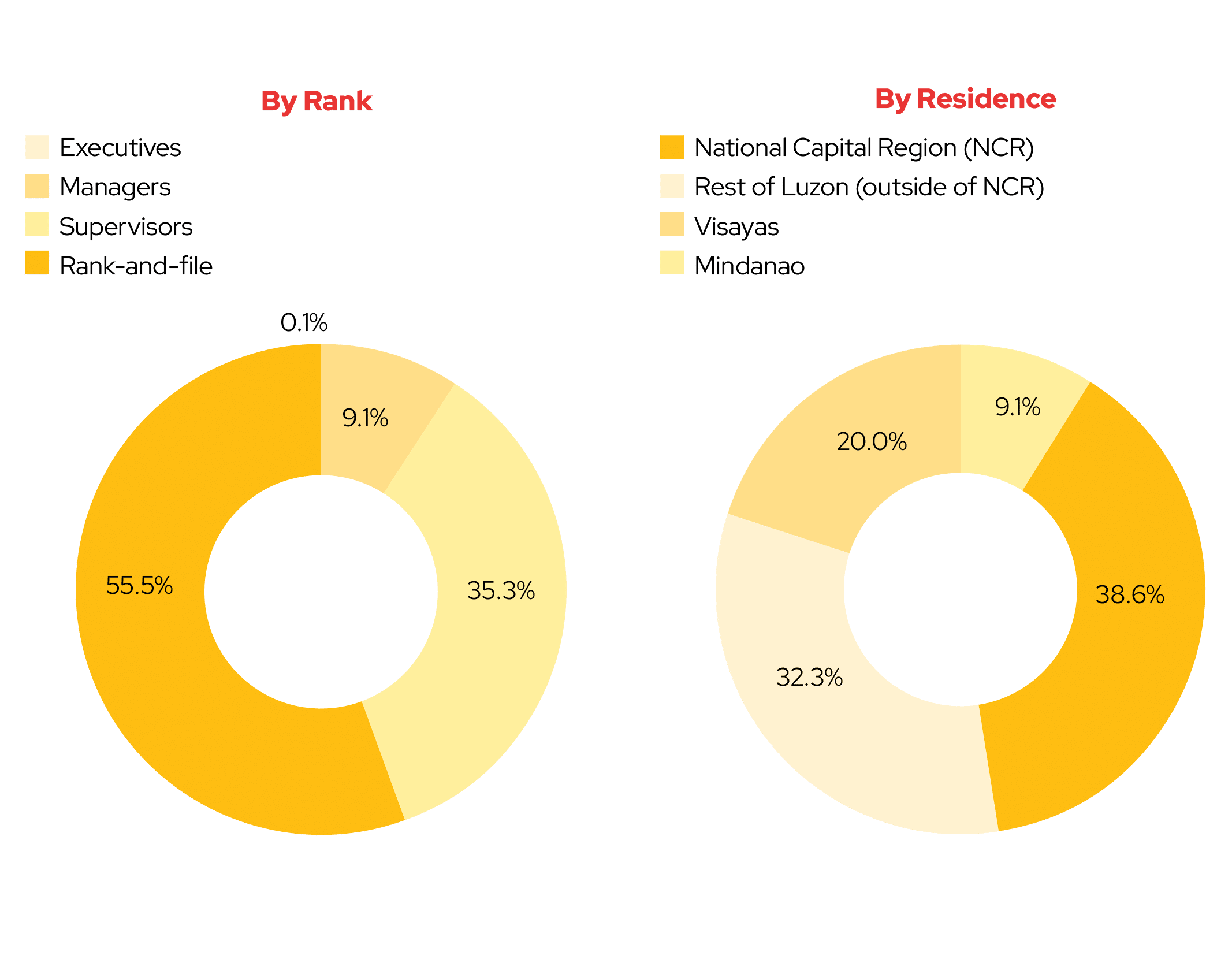

Diversity and Equal Opportunity
Employees in the Workforce

Employees in Executive-Level Positions

Employees in Managerial Roles

Employees in Supervisory Roles

Employees in Rank-and-File Positions

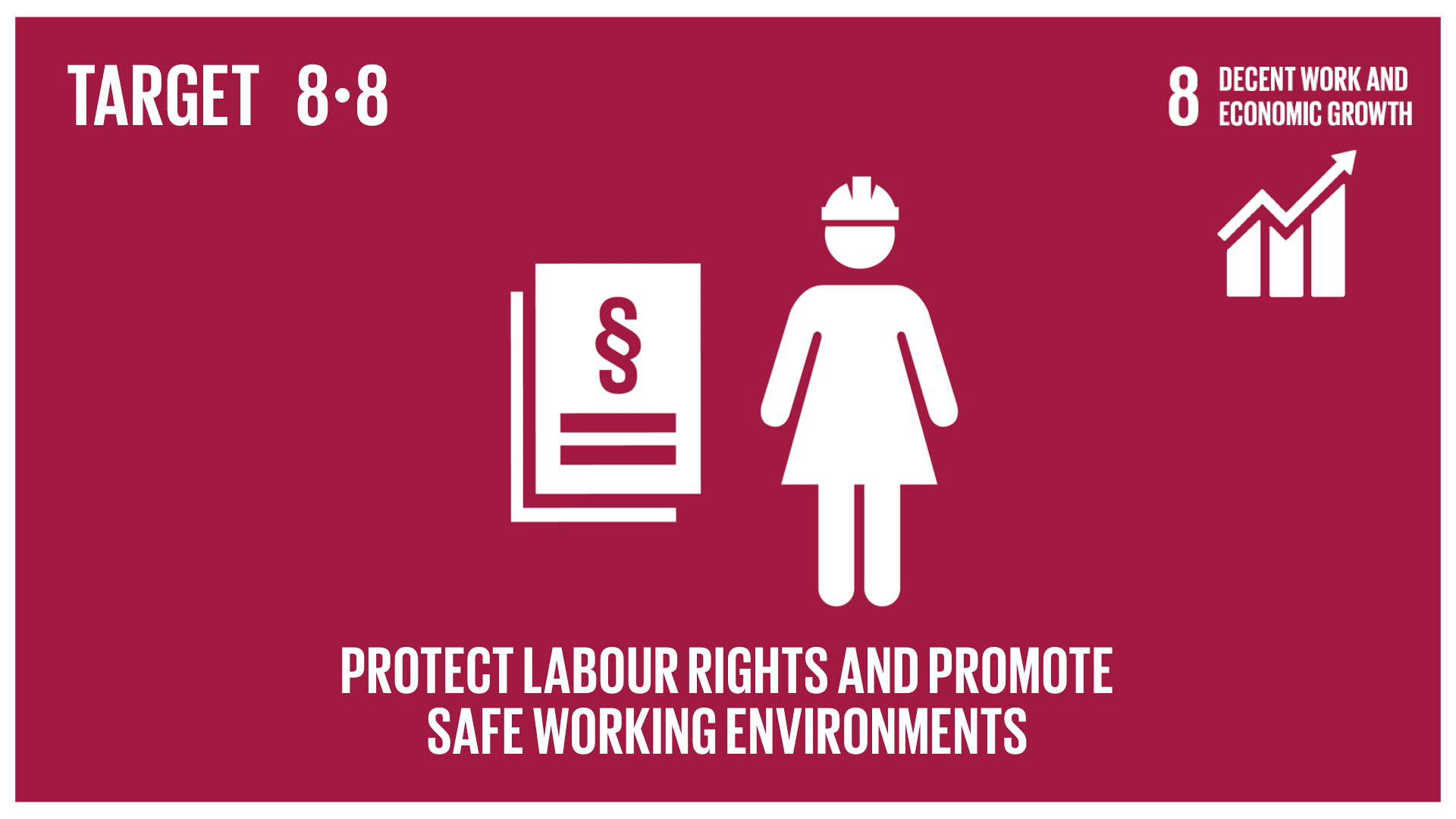
A Safe Place to Work
Ensuring the occupational health and safety of our employees is
paramount to us as it directly impacts overall well-being and
productivity. We adhere to stringent safety, health, and welfare
standards established by the Department of Labor and Employment
to guarantee safe and healthy working conditions for everyone
who interacts with our establishments.
In addition to complying with regulatory requirements, we
maintain comprehensive Security and Safety Manuals that undergo
regular review to ensure their ongoing effectiveness and
relevance. These manuals serve as vital resources for our teams,
providing clear guidance on best practices and protocols to
mitigate risks and respond effectively in emergency situations.
To further bolster our preparedness, we have established a
Corporate Emergency Response Team (CERT) entrusted with leading
crisis management initiatives across our conglomerate. The CERT
oversees the periodic review of contingency plans and emergency
preparedness procedures to uphold our commitment to effective
responses and responsible crisis management.
By prioritizing occupational health and safety and maintaining
robust emergency response mechanisms, we strive to create a
secure and resilient environment for our employees, customers,
and stakeholders alike.
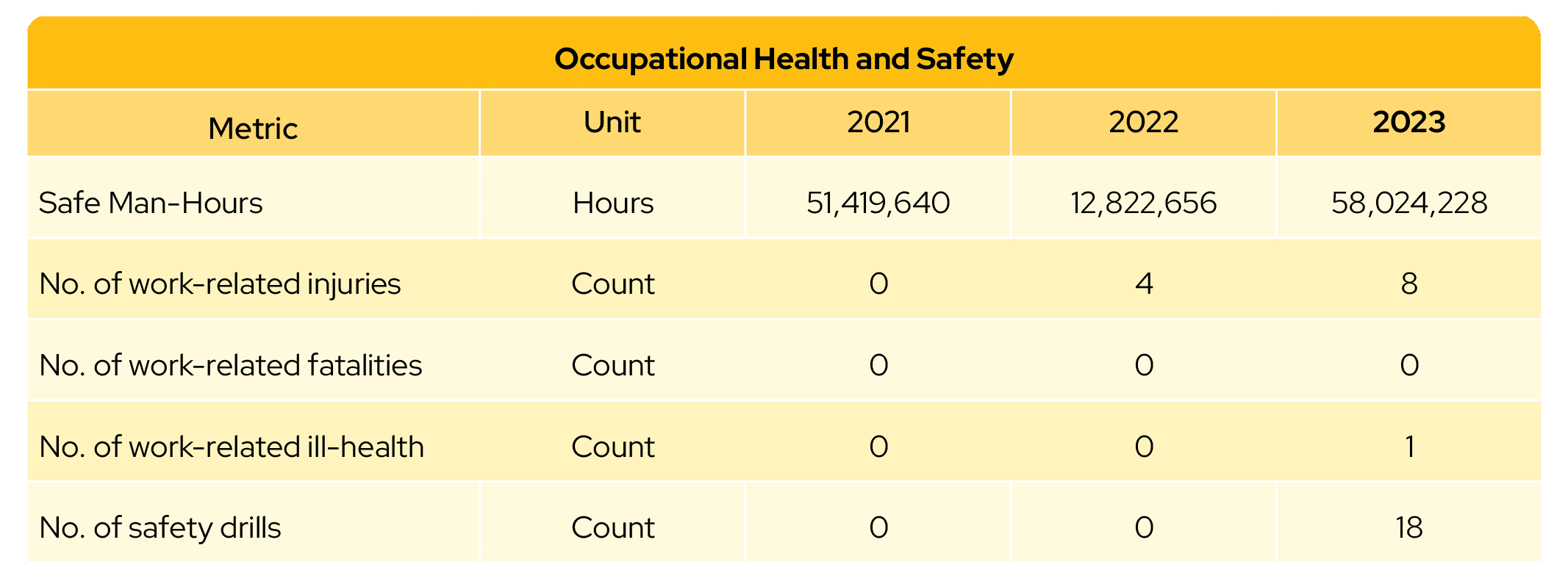
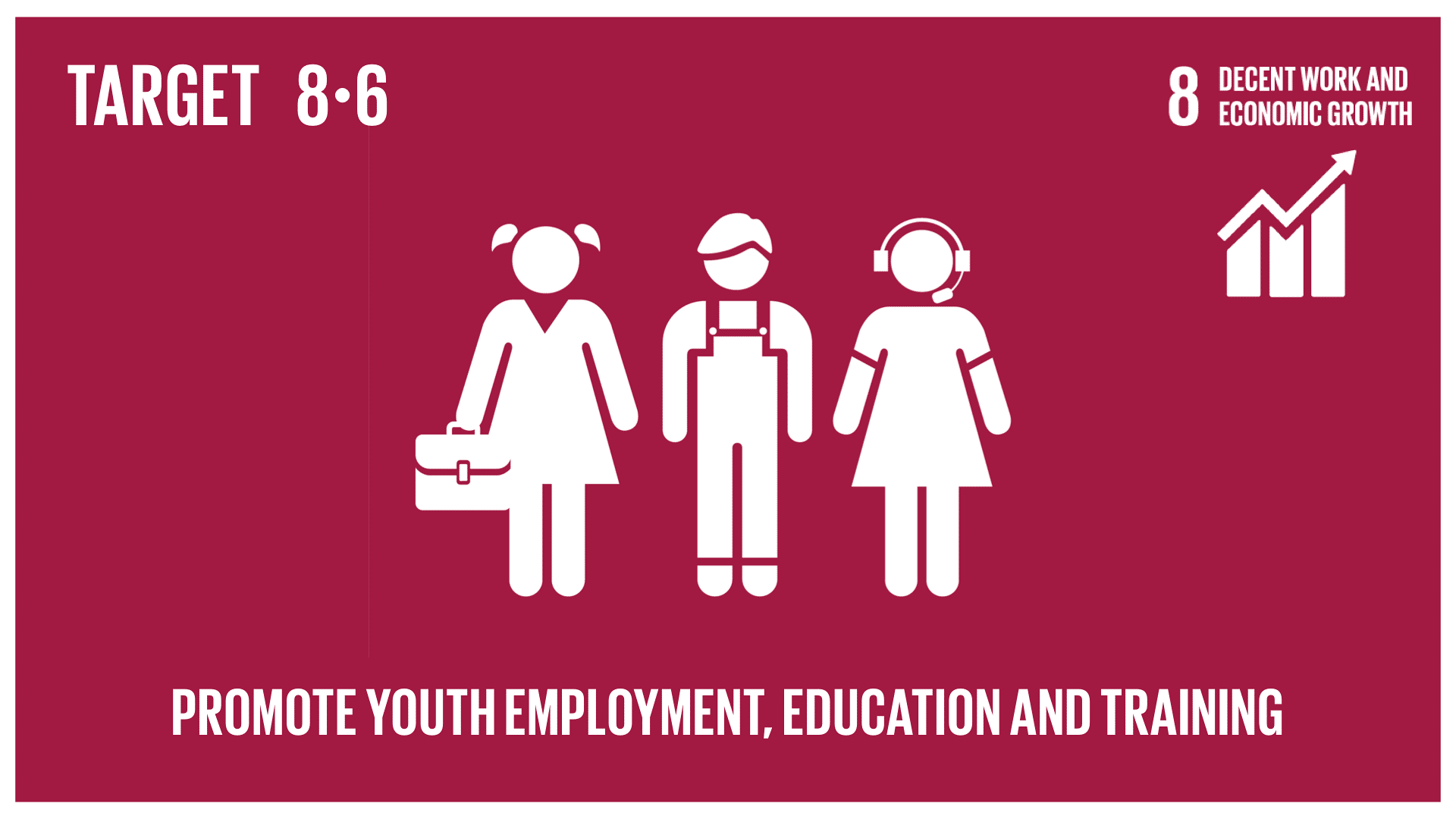
Robinsons Retail Academy
We believe in investing in our people, empowering them to reach their full potential and thrive in their roles. Through comprehensive training programs, personalized development plans, and continuous learning opportunities, we equip our employees with the skills and knowledge they need to excel.
Robinsons Retail Academy Curricula
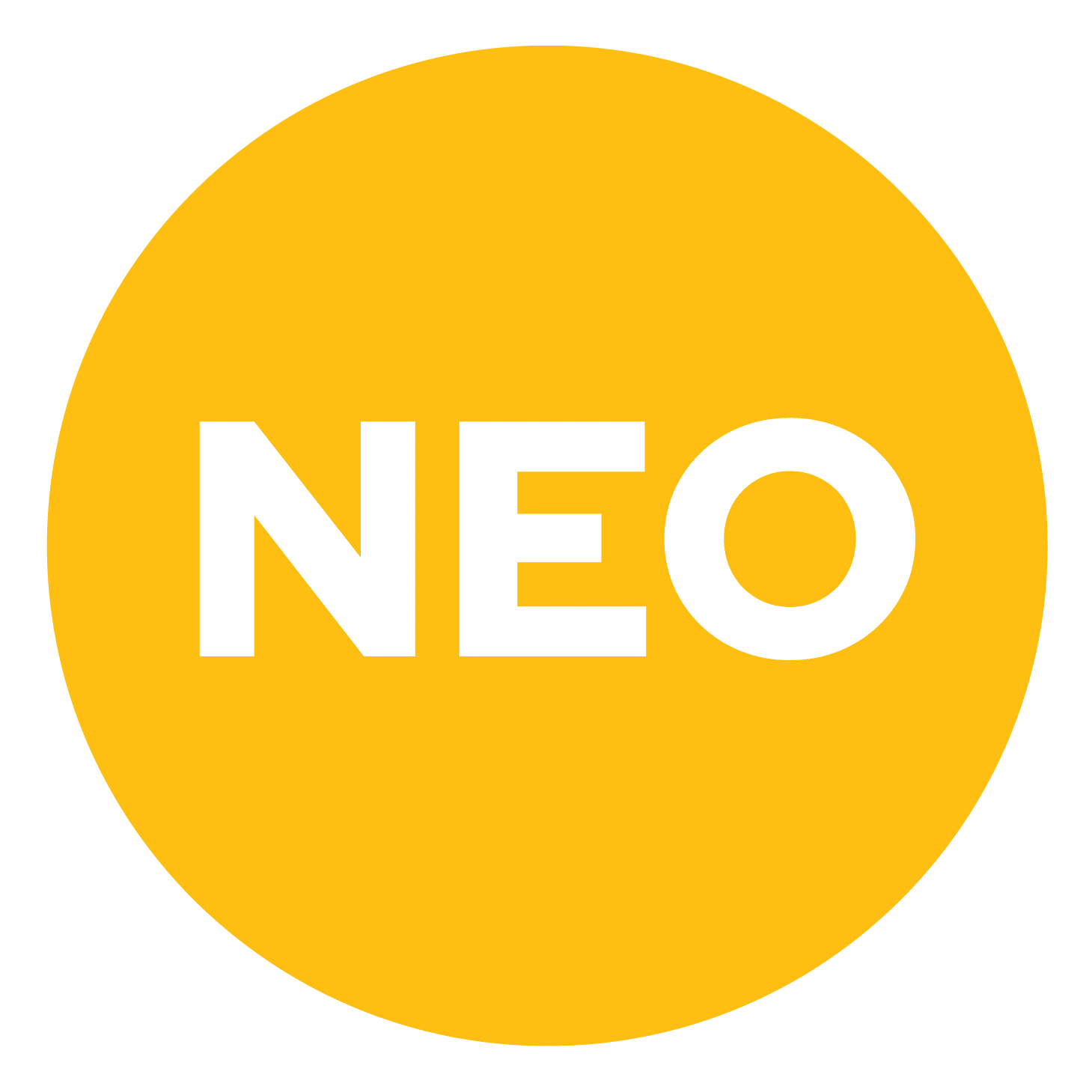
New Employee Orientation
An employee orientation program for new RRHI employees

Digital Learning Program
A set of bi-weekly programs focusing on essential skills, knowledge and mindest: the courses focus on Personal Excellence, People Excellence and Operational Excellence.

Retail Excellence Curriculum
A set of learning roadmaps per level for all regular employees focusing on building retail-based leadership and maangement competencies.

Management Development Curriculum
A set of learning roadmaps for key talents focusing on developing them for their current and future roles aligned to both functional and leadership management competencies
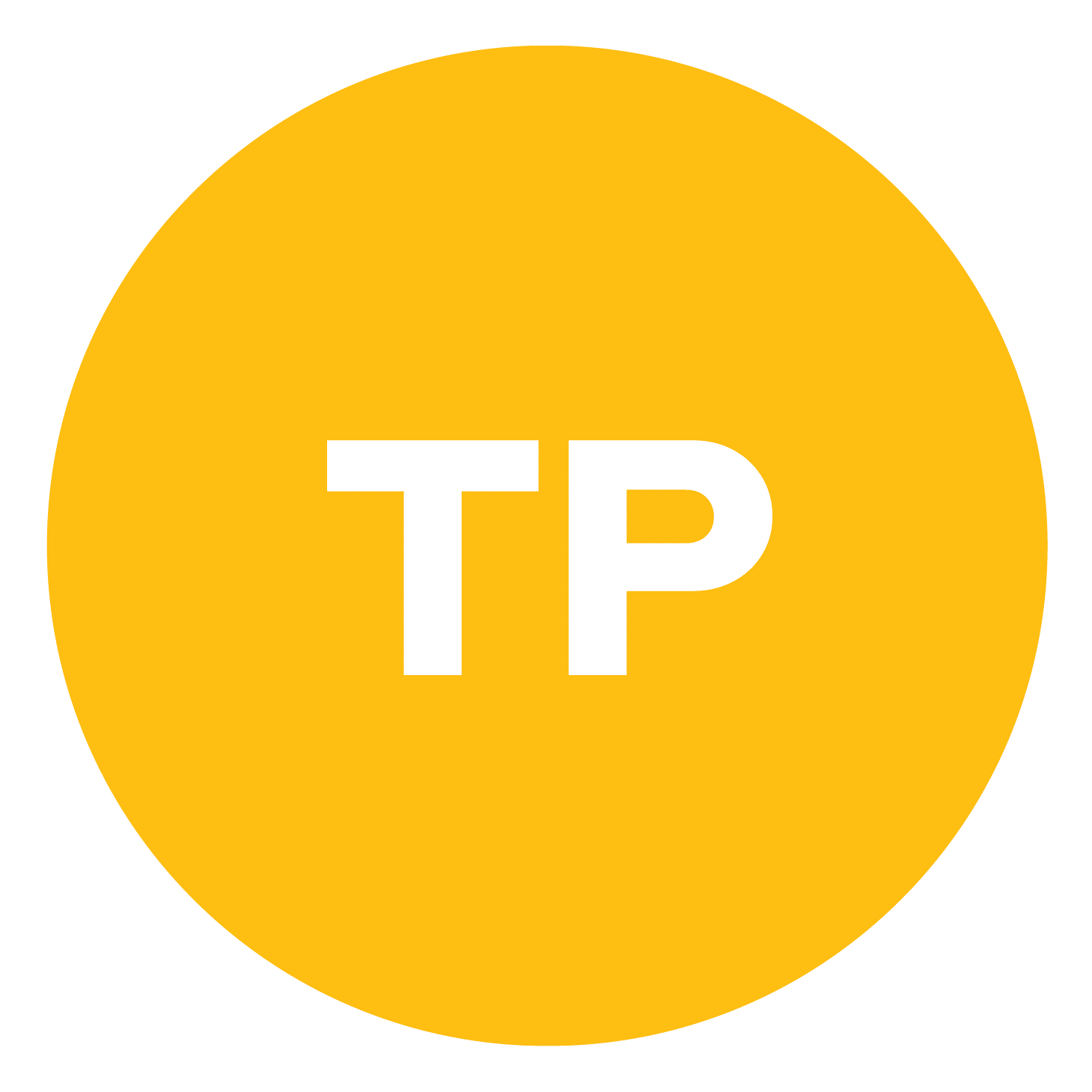
Thematic Programs
A pool of capability building programs supporting the organization’s goals and strategies (e.g. Supply Chain, Customer Experience)
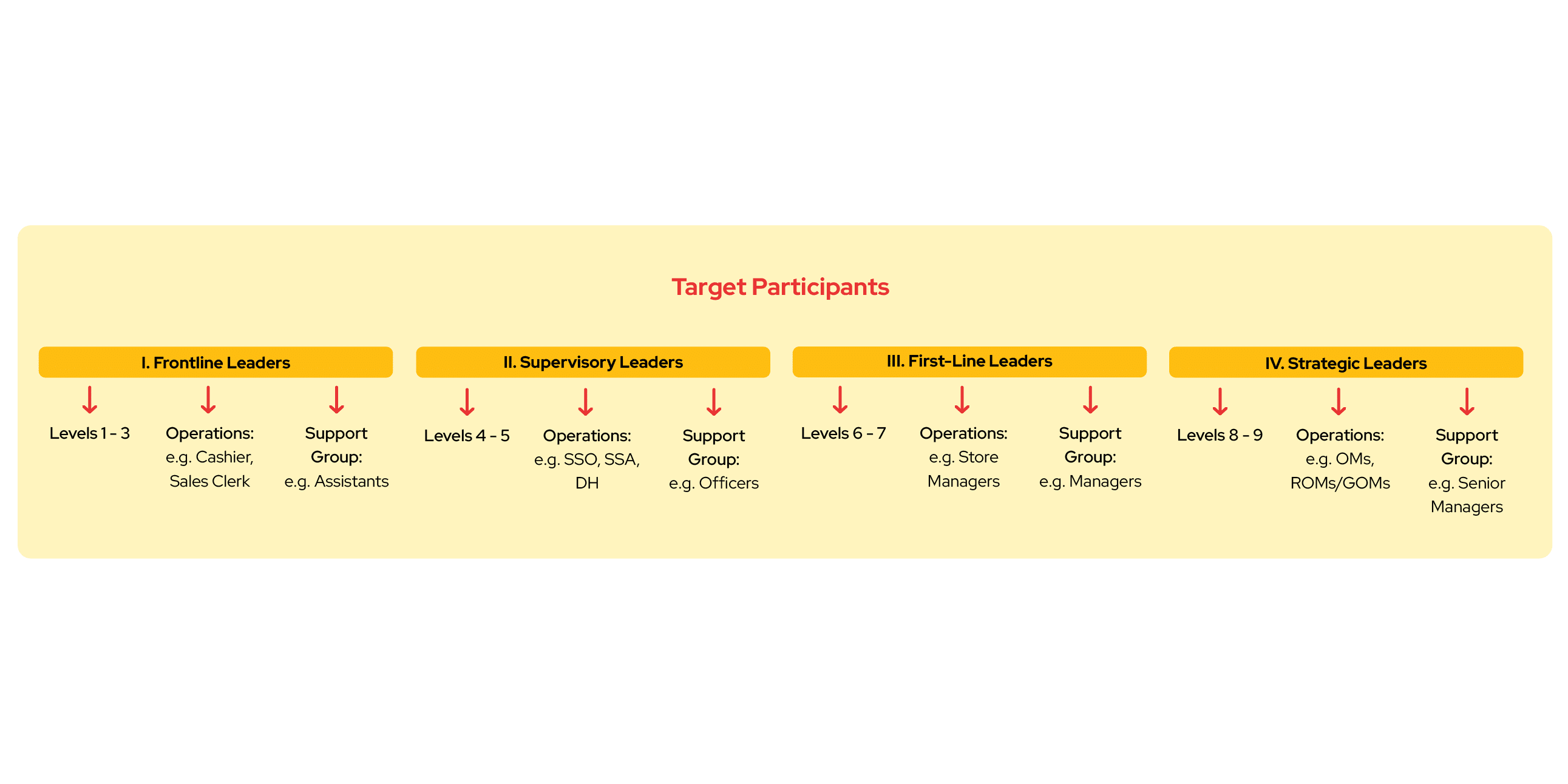
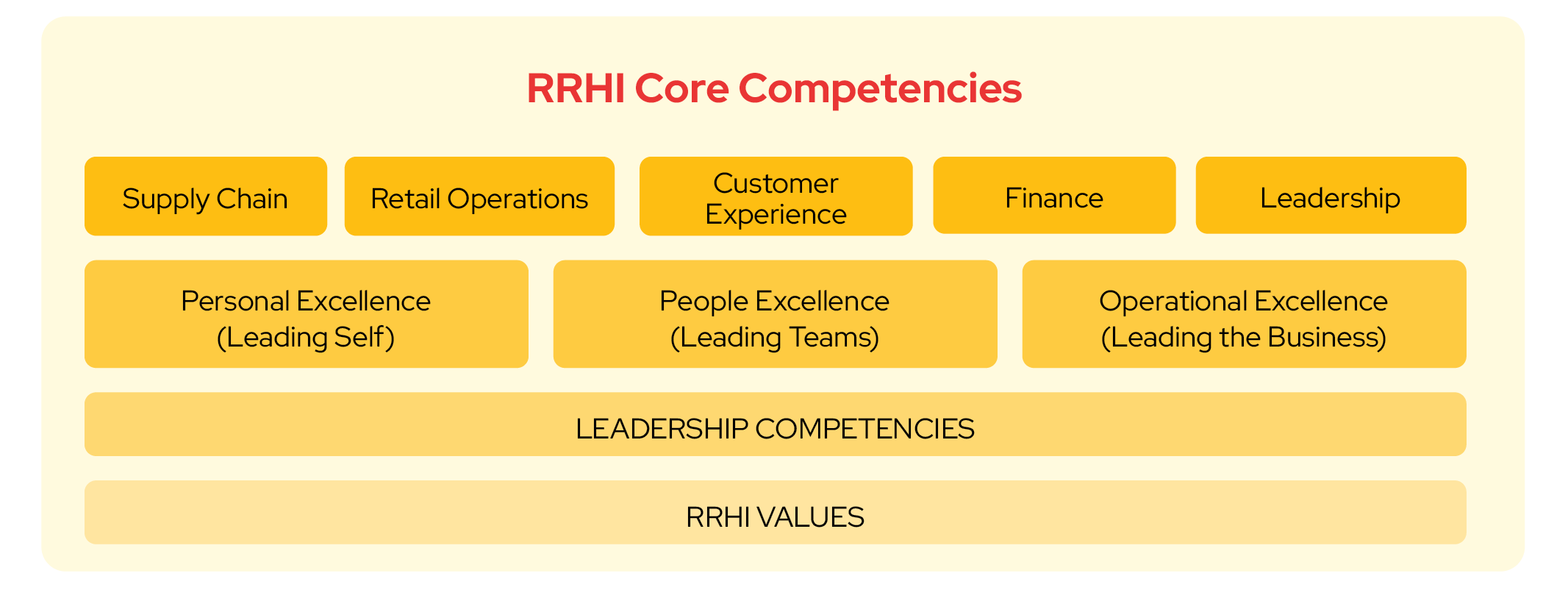
The Robinsons Retail Academy (RRA) is a flagship initiative
crafted by our Learning & Organizational Development
(L&OD) team to provide learning opportunities to its
employees. RRA is a beacon of structured employee development,
offering a comprehensive array of learning opportunities
tailored to enhance skills, deepen knowledge, and cultivate
expertise across the Company.
With a focus on aligning training initiatives with our business
objectives, RRA serves as a centralized hub for all things
learning. The RRA provides a unified platform streaming access
to a diverse range of courses, workshops, and seminars.
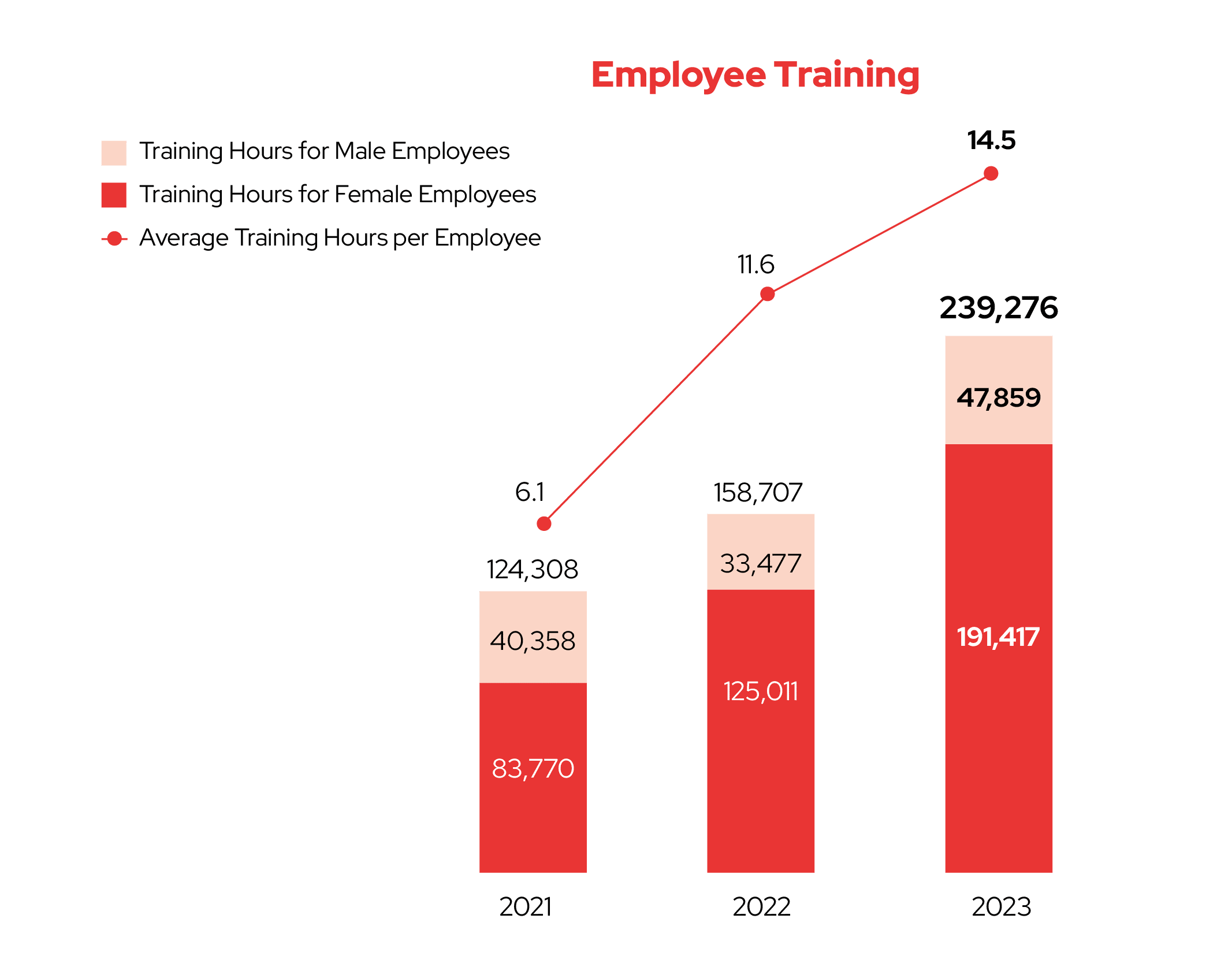


Sustainability 101
As part of our New Employment Orientation program, new employees
also receive a comprehensive overview of sustainability within
the context of the Company’s operations against the broader
global landscape. Robinsons Retail’s Sustainability Manager
provides an overview of our sustainability initiatives,
emphasizing our responsibility to minimize our environmental
impact, support local communities, and promote ethical practices
throughout our supply chain.
Through real-world examples and interactive discussions,
employees uncover the tangible ways they can contribute to our
sustainability efforts, both within and outside the workplace
fostering a sense of stewardship from day one. We empower our
new hires to become champions of sustainability within Robinsons
Retail and beyond.
Nurturing Partnerships for Shared Value
Our suppliers and trade partners are integral to our creation of
shared value as well as supporting the livelihood of various
businesses and providing access to goods for our end-consumers.
Currently, over 90% of our vendors are Philippine-based
manufacturers and distributors, including those that source
products abroad and serve as the official distributors of
foreign brands.
To reinforce our commitment to nurturing better relationships
with these essential partners, we continue to work towards
improving forecasting demand to maintain just-in-time inventory
deliveries to increase supply efficiency allowing us to reduce
shrinkage or wastage. Through the cross-docking systems at our
distribution centers, we are also able to speed up the delivery
of products and reduce the unnecessary maintenance of stocks.
To thank our partners for a successful 2023, we held our annual
Trade Partners Nights highlighting the vital contributions of
our partners as we continue to create value, drive excellence,
and deliver unparalleled service to the customers and
communities we serve.

Energy Management and Climate Action
As our store and office operations rely heavily on electricity and fuel, we remain steadfast in our commitment to reducing our carbon footprint. We continue to convert our refrigeration and air-conditioning systems using lower-impact refrigerants and explore energy-efficient technologies. We will start to conduct more rigorous energy and emission reduction studies and explore renewable power purchase partnerships, prioritizing facilities with higher energy consumptions in order to eventually reduce our energy and emission intensity as we continuously expand our store network.
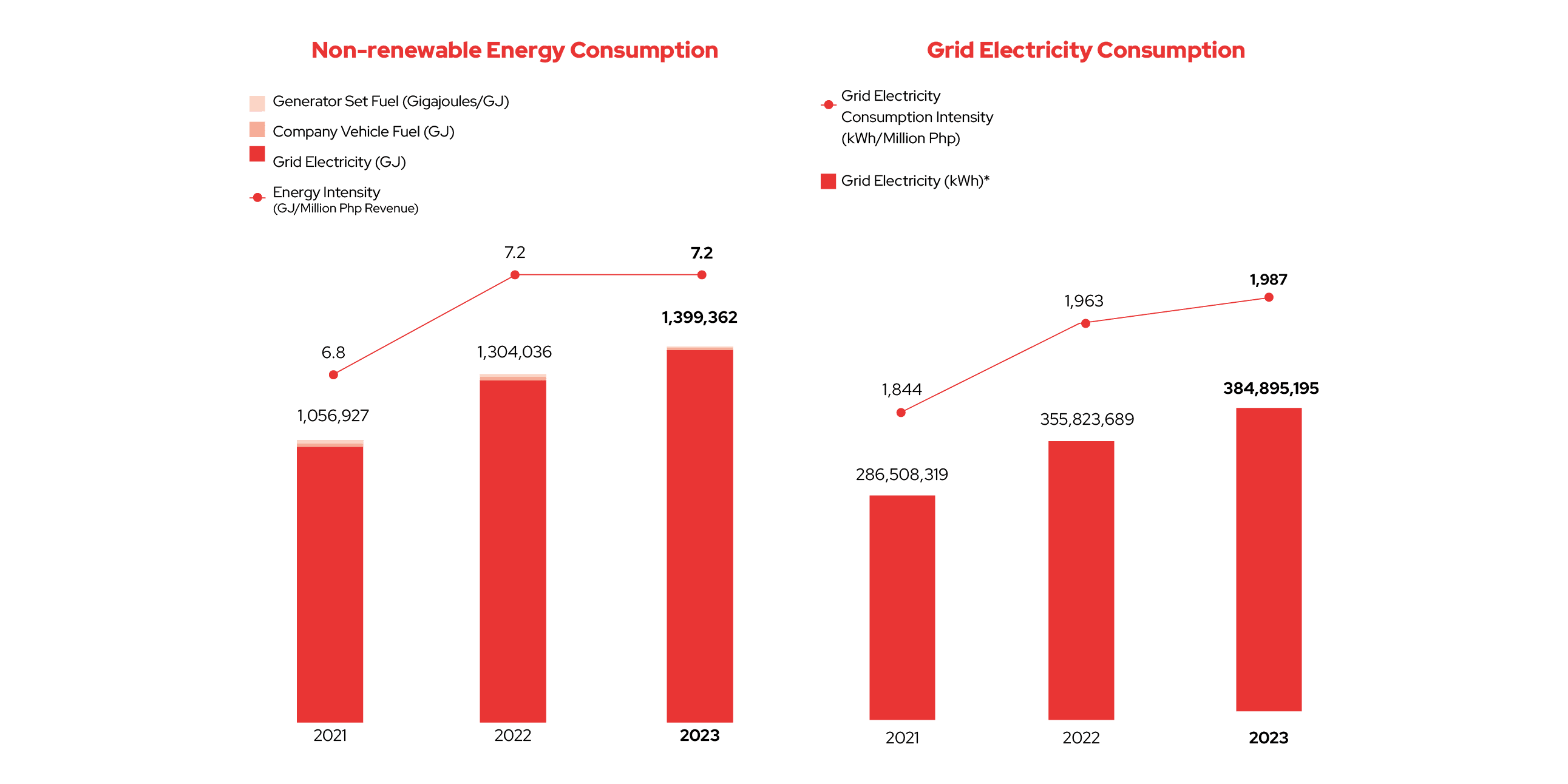
* Restated 2021 and 2022 values due to the original inclusion of third-party manpower wages in the employee wages and benefits.
GHG Emissions (Scope 1 and 2)
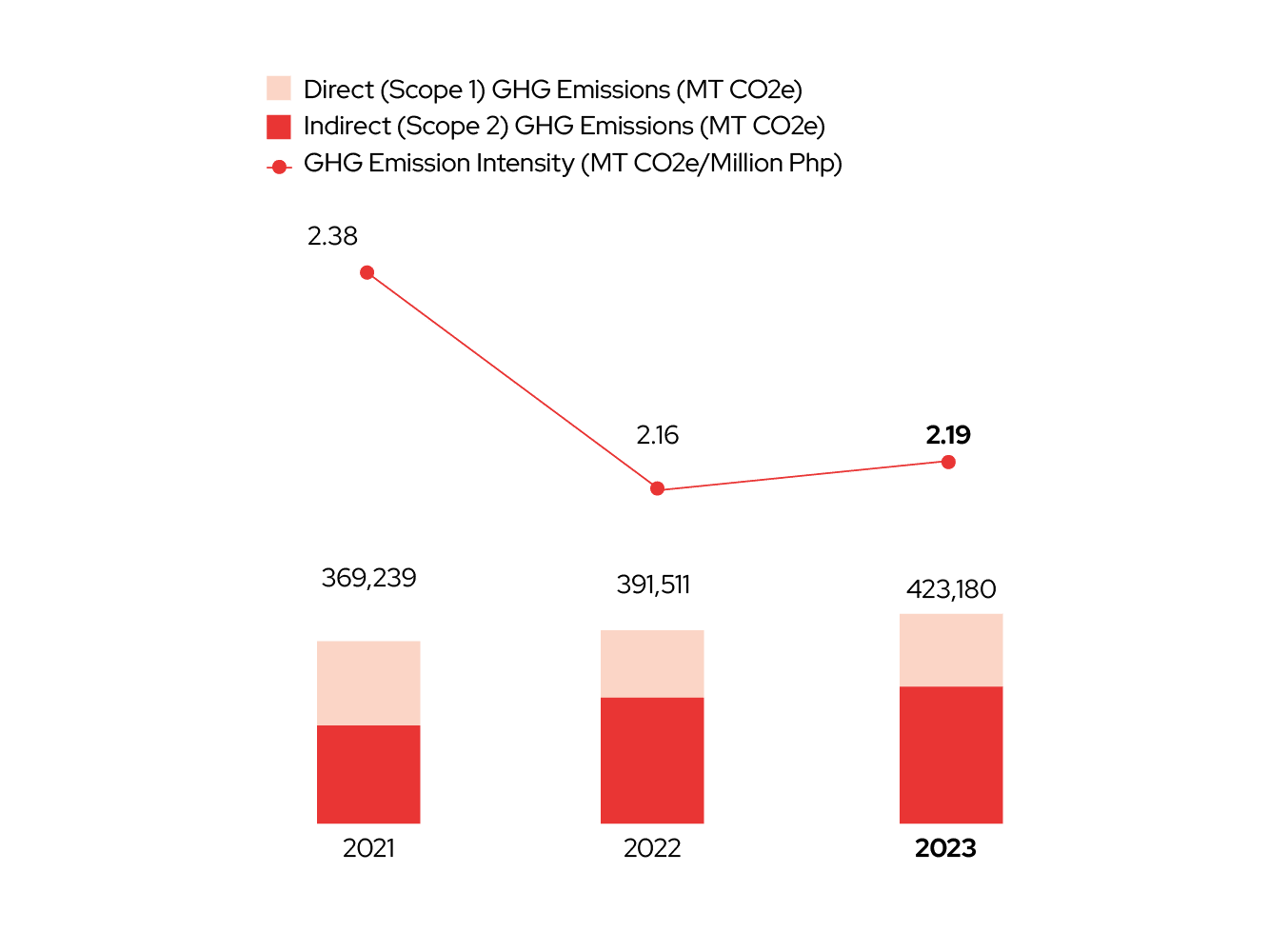
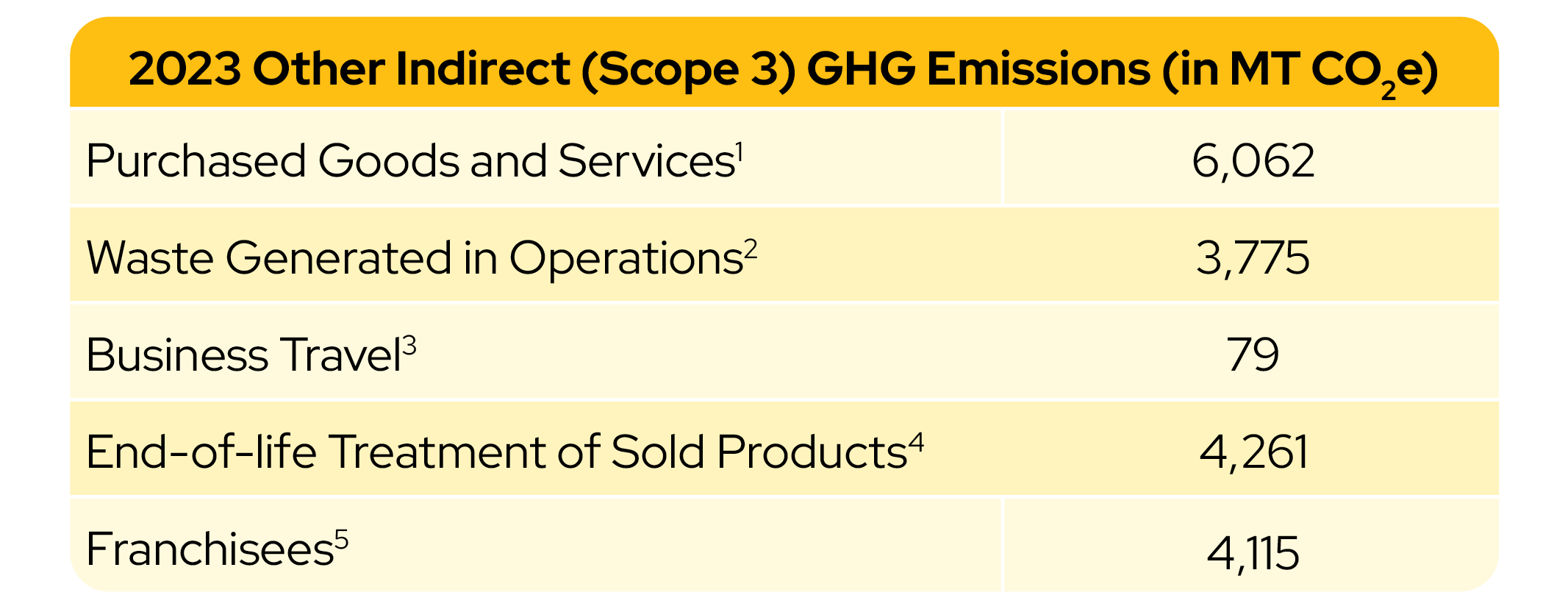
1 Based on renewable materials (paper bags) and non-renewable
materials (plastic bags) consumption
2 Based on solid waste generation
3 Based on fuel consumption of rented vehicles
4 Based on plastic footprint of sold house brands
5 Based on electricity consumption of Uncle John's franchised
stores
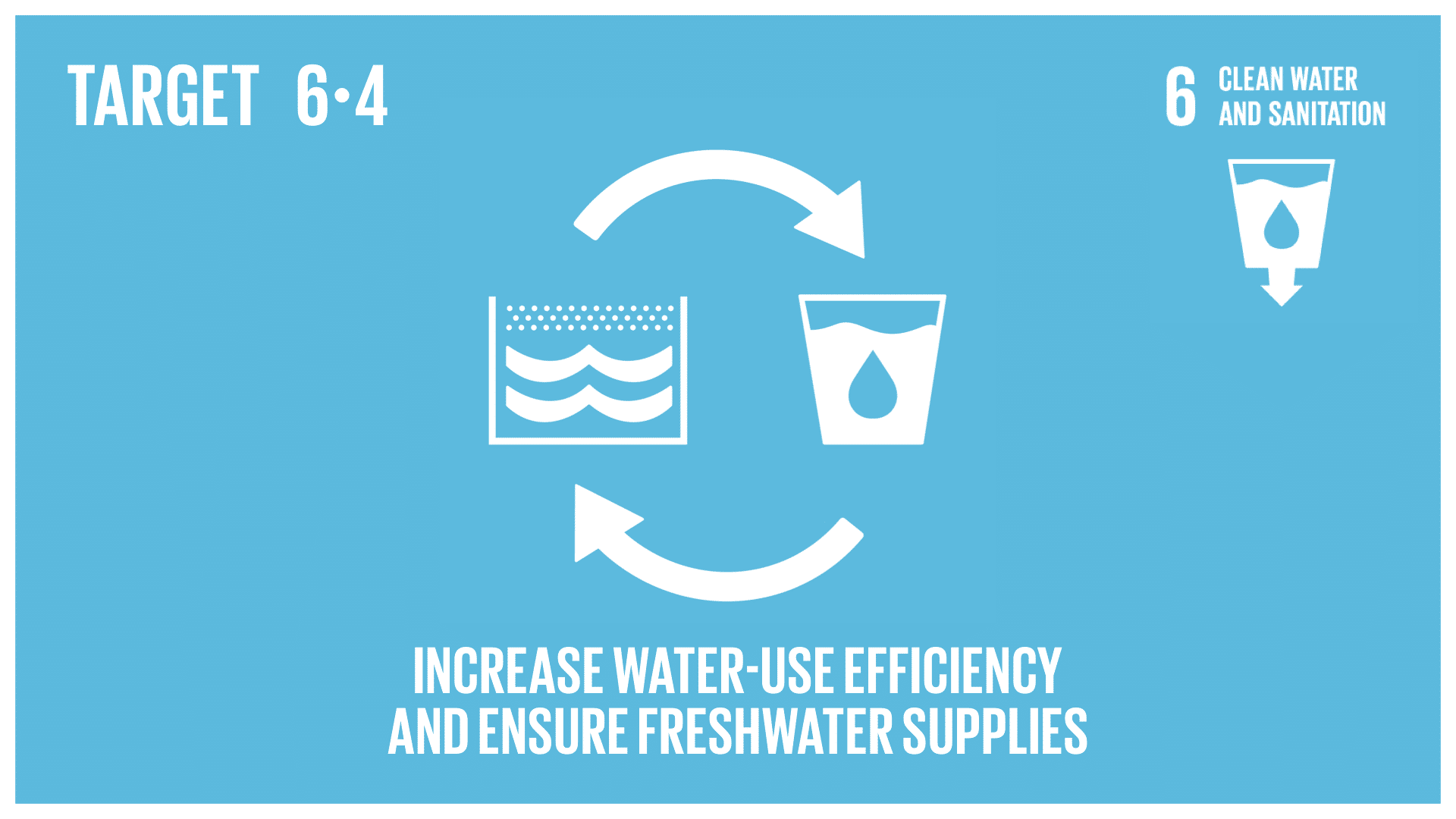
Water Management
While our operations may not demand extensive water usage
compared to certain industries, we uphold a vigilant stance on
monitoring our water consumption. Sourcing water from
local-third party lines, we prioritize efficient and responsible
usage practices across our offices and stores.
Our water use mainly stems from office and store lavatory
facilities and routine maintenance and cleanliness protocols. To
mitigate waste and conserve water, we implement regular
monitoring of our plumbing and water systems. By proactively
identifying and rectifying issues such as leakages, we minimize
the risk of significant water loss and ensure sustainable
management of this essential resource. The increase in 2023
water consumption is a result of the data gathering improvements
from our stores and warehouses.
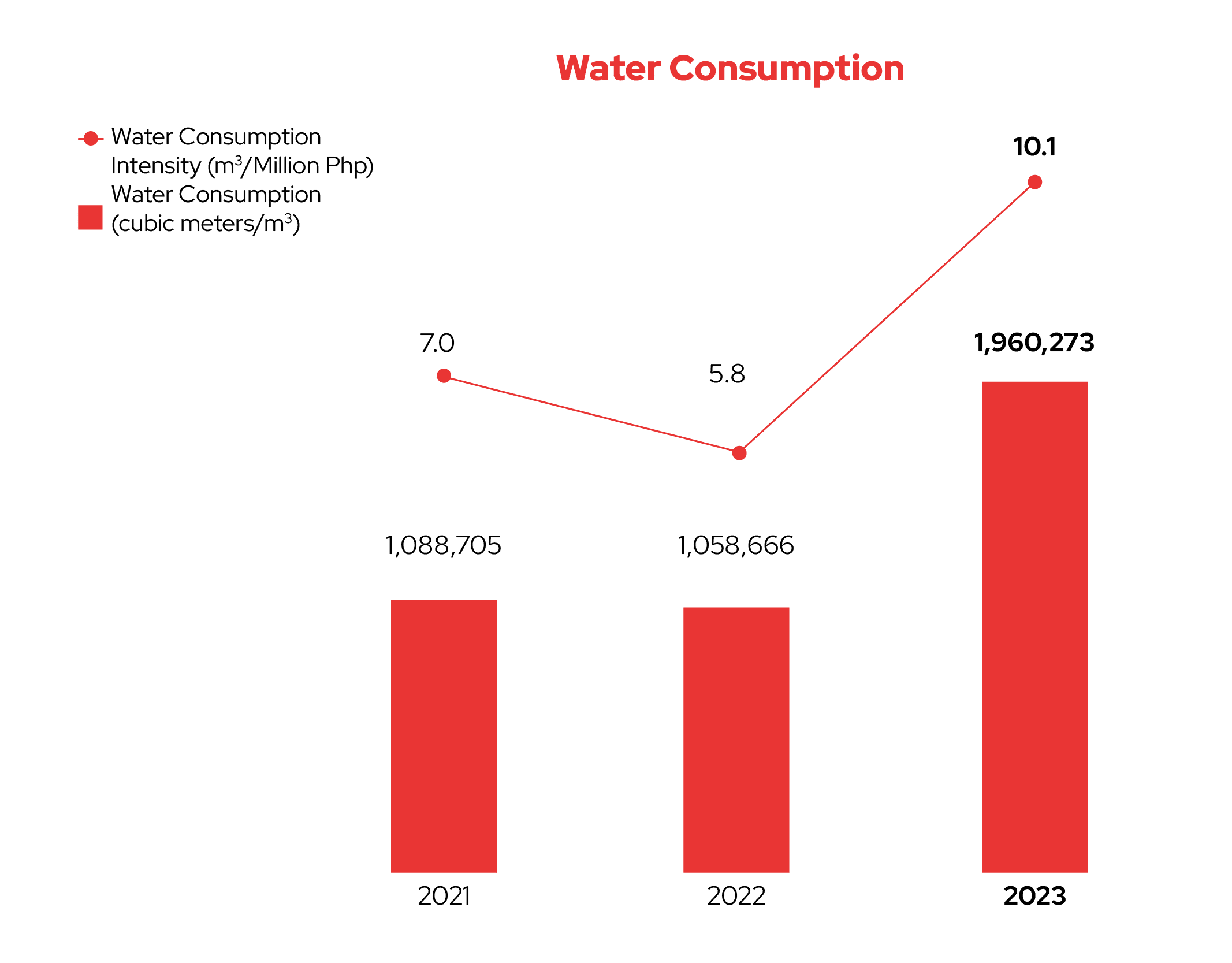

Climate Resilience Project
Our Journey towards Climate Action
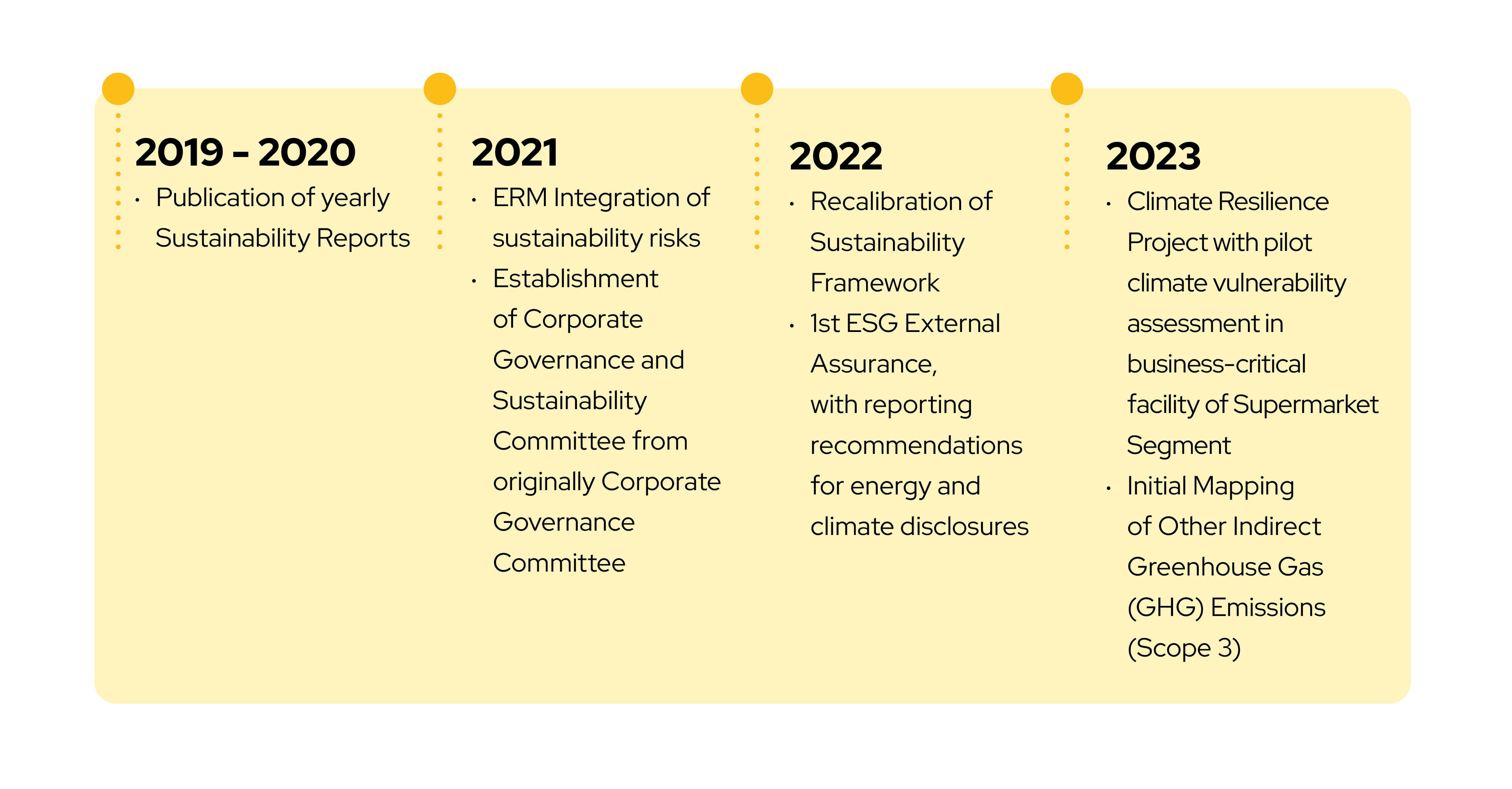
As a business, we continue to do our part for climate action.
This journey began in 2019 with the publishing of our inaugural
stand-alone Sustainability Report.
In 2021, we embedded sustainability and climate risk
considerations into our ERM framework. We also embedded
Sustainability into our Corporate Governance committee as we
intend to drive more sustainability and climate agenda in
board-level discussions. Aspiring to set our climate and
sustainability targets in the coming years, we recognized the
importance of a credible baseline data for target setting. Thus,
we engaged an independent consultant for our first ESG external
assurance covering 2022 disclosures, whereby reporting
improvements were recommended for energy and climate
disclosures. We also recalibrated our sustainability framework,
simplifying them to cover 4 focus areas reflecting the material
topics that our retail business must tackle at scale.
Continuing our momentum, we initiated our climate resilience
journey as we aim to solidify our climate mitigation and
adaptation targets and roadmap. This involved assessing our
exposure to physical climate hazards and conducting
vulnerability assessment of selected business-critical pilot
facility to develop tailored adaptation strategies. These
proactive steps position us to adhere to anticipated updates to
sustainability reporting guidelines, such as the SEC SR
Guidelines and the launch of the IFRS Sustainability Disclosure
Standards. We also started to initially map out and partially
disclose our other indirect GHG emissions across our value chain
(Scope 3 GHG emissions) as we commit to involve our stakeholders
across our value chain to participate in climate action. These
milestones lay the groundwork for a strategic shift towards a
more sustainable and climate-resilient future, setting the tone
for years to come.
Our Approach and Strategy in Climate Resilience
Situated in an archipelagic region prone to tropical cyclones, our businesses face such inherent climate hazards. Intense tropical cyclones, flooding, and rising temperatures could adversely impact our assets, operations, and workforce. As a foundational step in our climate strategy, we have identified and assessed climate-related physical risks and opportunities at a facility-level, alongside their operational and business impacts. We have evaluated our climate resilience in coping with the various climate scenarios. This process allowed us to gauge the inherent resilience of our assets and develop tailored risk mitigation strategies to enhance operational efficiency and business continuity. This targeted analysis represents the first phase of a broader strategy that we plan to be replicated across our portfolio of critical operational assets. We are integrating this climate resilience assessment into our business processes, utilizing them to refine strategic planning, and strengthen our Enterprise Risk Management and Business Continuity Planning. This ensures our approach to managing climate risks is robust and actionable at the operating unit level.
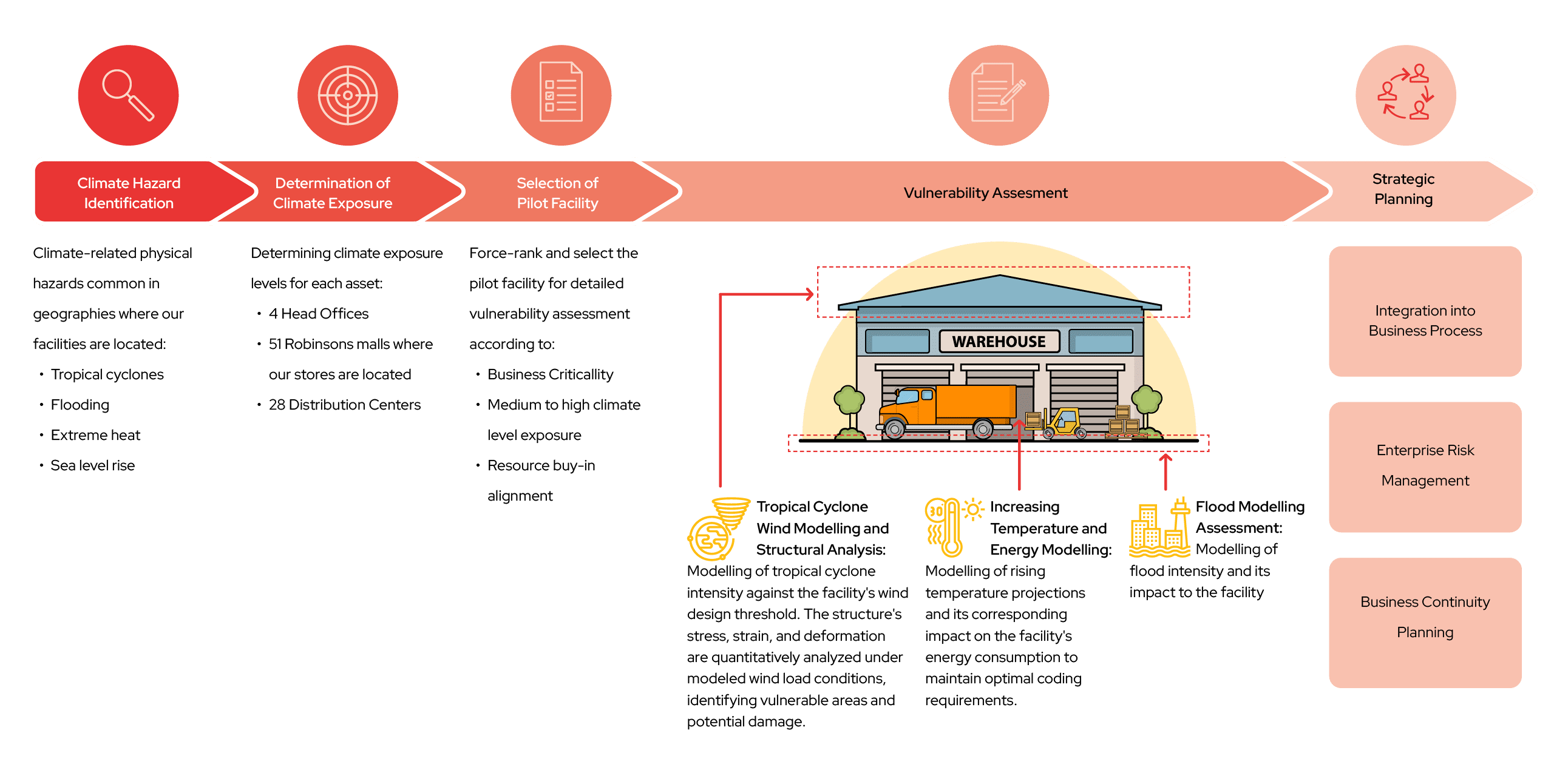
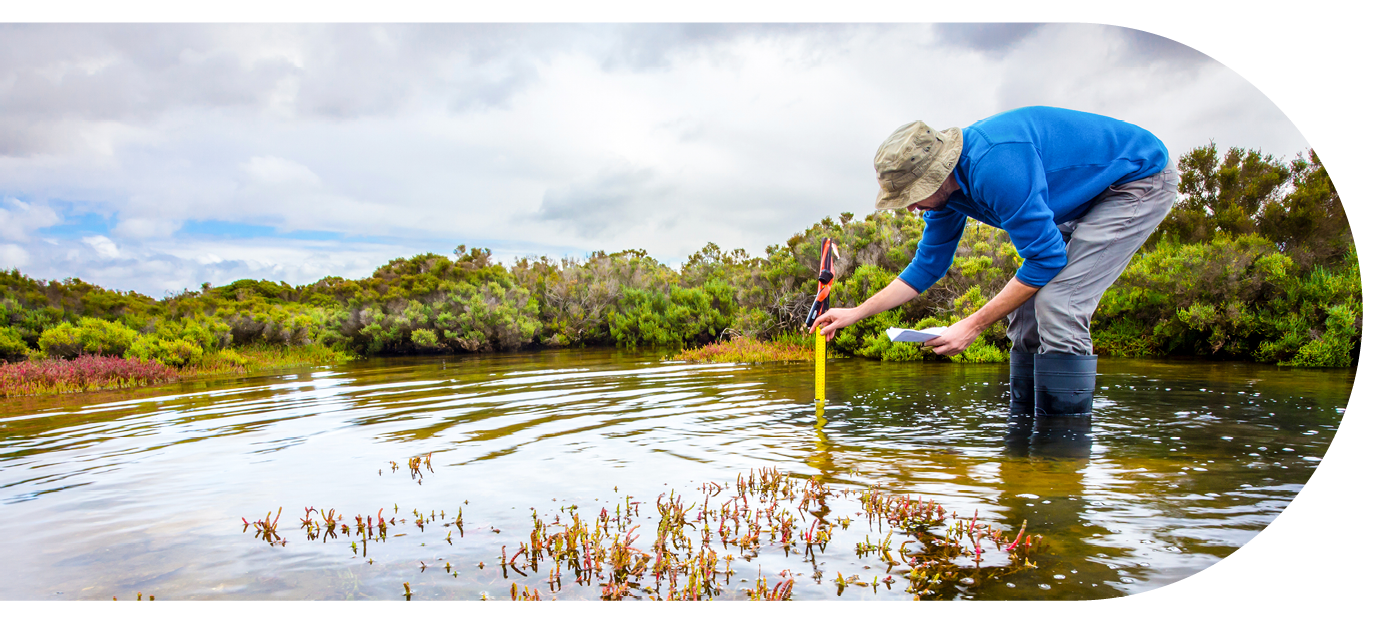
Overview of Our Climate Resilience Assessment Process
a. Climate Scenarios
Understanding climate information is crucial for assessing
the impact of both physical and transition risks across
various future scenarios and making informed decisions for
adaptation and mitigation strategies. This is critical as it
allows us to assess potential future impacts of both
physical hazards and the transition to a low-carbon economy.
By considering various climate futures, we can make informed
decisions on adaptation strategies to strengthen our
operations and mitigation efforts to reduce our
environmental footprint, ensuring long-term business
resilience.
IPCC's Representative Concentration Pathways (RCP) 8.5 and
4.5 was selected for our analysis. RCP 8.5 represents a high
emission scenario, indicating a future where greenhouse gas
emissions continue to rise rapidly leading results in
greater impacts from physical hazards such as higher global
temperature increase, intense extreme weather events and
faster sea-level rise as a consequence of inaction on
climate change. Conversely, RCP 4.5 represents a scenario
where emissions peak around mid-century before declining. By
considering both pathways, we encompass a broad spectrum of
potential future emissions trajectories for climate-related
physical risks.
Our definitions of short-term (1-5 years), medium-term (6-15
years), and long-term (16 years and beyond) closely mirror
the general timeframes used in our strategic
decision-making. The 2030-2060 timeframe, which falls under
medium-term to long-term, was chosen to match the projected
timelines of climate models and the operational lifespan of
assets, ensuring the assessments remain relevant.
Additionally, in 2025, we plan to evaluate the impacts of
the low-carbon transition and climate-related transition
risks and opportunities on our business under the RCP 2.6
scenario.
Understanding climate information is crucial for assessing
the impact of both physical and transition risks across
various future scenarios and making informed decisions for
adaptation and mitigation strategies. This is critical as it
allows us to assess potential future impacts of both
physical hazards and the transition to a low-carbon economy.
By considering various climate futures, we can make informed
decisions on adaptation strategies to strengthen our
operations and mitigation efforts to reduce our
environmental footprint, ensuring long-term business
resilience.
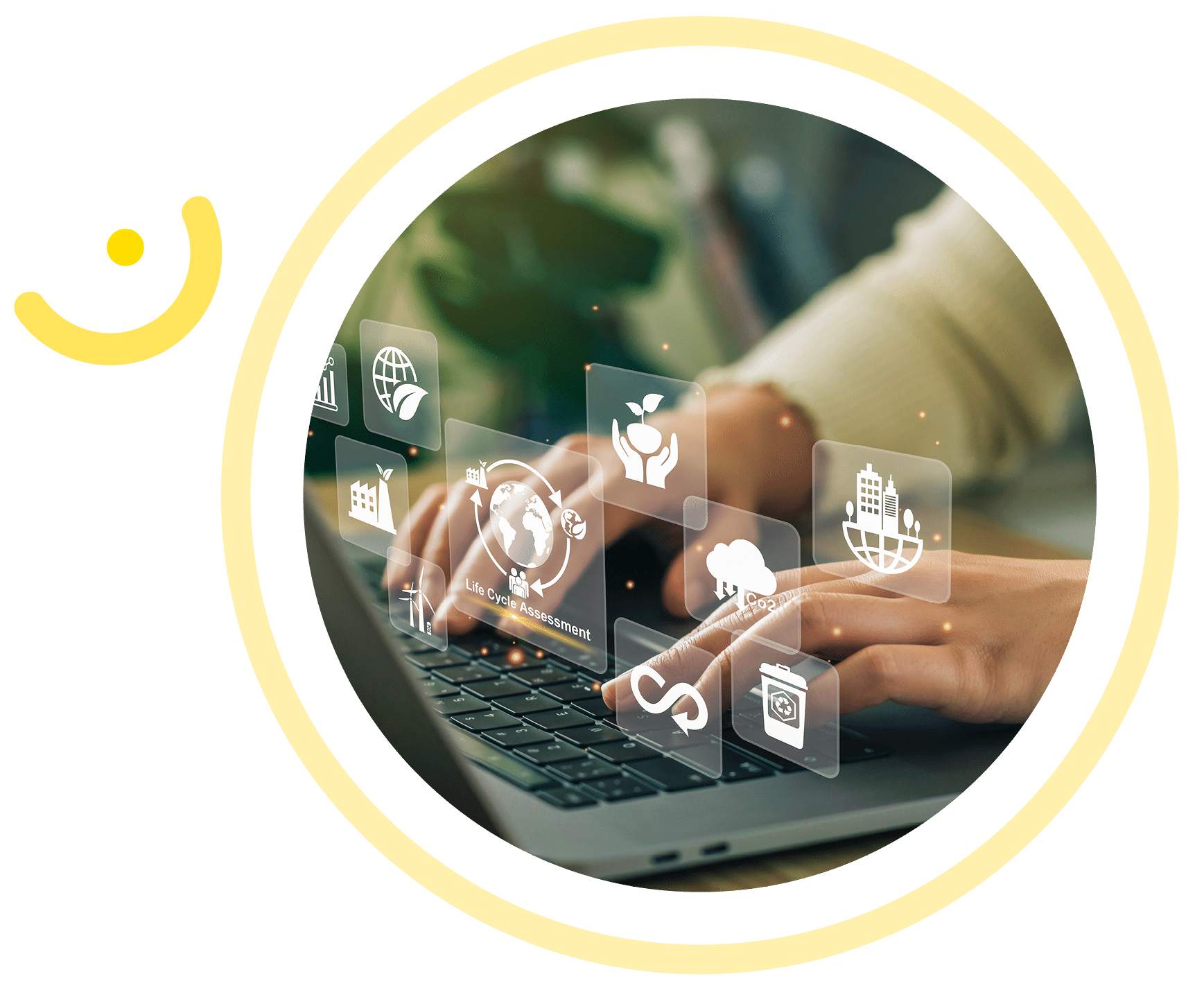

IPCC's Representative Concentration Pathways (RCP) 8.5 and 4.5
was selected for our analysis. RCP 8.5 represents a high
emission scenario, indicating a future where greenhouse gas
emissions continue to rise rapidly leading results in greater
impacts from physical hazards such as higher global temperature
increase, intense extreme weather events and faster sea-level
rise as a consequence of inaction on climate change. Conversely,
RCP 4.5 represents a scenario where emissions peak around
mid-century before declining. By considering both pathways, we
encompass a broad spectrum of potential future emissions
trajectories for climate-related physical risks.
Our definitions of short-term (1-5 years), medium-term (6-15
years), and long-term (16 years and beyond) closely mirror the
general timeframes used in our strategic decision-making. The
2030-2060 timeframe, which falls under medium-term to long-term,
was chosen to match the projected timelines of climate models
and the operational lifespan of assets, ensuring the assessments
remain relevant. Additionally, in 2025, we plan to evaluate the
impacts of the low-carbon transition and climate-related
transition risks and opportunities on our business under the RCP
2.6 scenario.
b. Climate Models and Tools
Our physical climate-risk modeling incorporates the current
advancements in climate science from peer-reviewed scientific
studies and is subject to refinement as our understanding of
climate science evolves. For temperature projections, we rely
on the high-resolution data from the Coordinated Regional
Climate Downscaling Experiment for Southeast Asia
(CORDEX-SEA), ensuring detailed spatial and temporal analysis.
The assessment of future tropical cyclone frequency and
intensity utilizes data from the IPCC's Coupled Model
Intercomparison Project Phase 6 (CMIP6), which incorporates
atmospheric, oceanic, land surface, and sea parameters.
Additionally, our flood modeling is conducted using
hydrological analysis with Hydrologic Engineering Center –
Hydrologic Modelling System (HEC-HMS) to generate hydrographs
and flood maps, incorporating projected rainfall data from
PAG-ASA's Climate Information and Risk Analysis Matrix
(CLIRAM), ensuring our models are both current and with high
spatial and temporal resolution to capture the specific
climatic feature of the region.
c. Mapping and assessment of climate hazard exposure levels across our facilities
As first step in ensuring long-term resilience of our
operations, we conducted a comprehensive climate hazard
exposure assessment across 83 facilities, comprising of 4 head
offices, 28 distribution centers, and 51 Robinsons malls where
a significant number of our stores are located. This
assessment focused on four key climate hazards: flooding, sea
level rise, extreme heat, and tropical cyclones. We leveraged
geospatial mapping to pinpoint the location of each facility
in relation to potential climate hazards which allowed us to
assess the corresponding level of climate exposure for each
facility. This crucial first step has enabled us to prioritize
facilities that require a deeper vulnerability analysis.
Key findings reveal that 48% of facilities are at high flood
hazard levels, 19% in low-lying coastal areas may face sea
level rise impacts, 8% are exposed to high heat hazards, and
8% to high tropical cyclone risks, highlighting distinct
vulnerability profiles across locations.
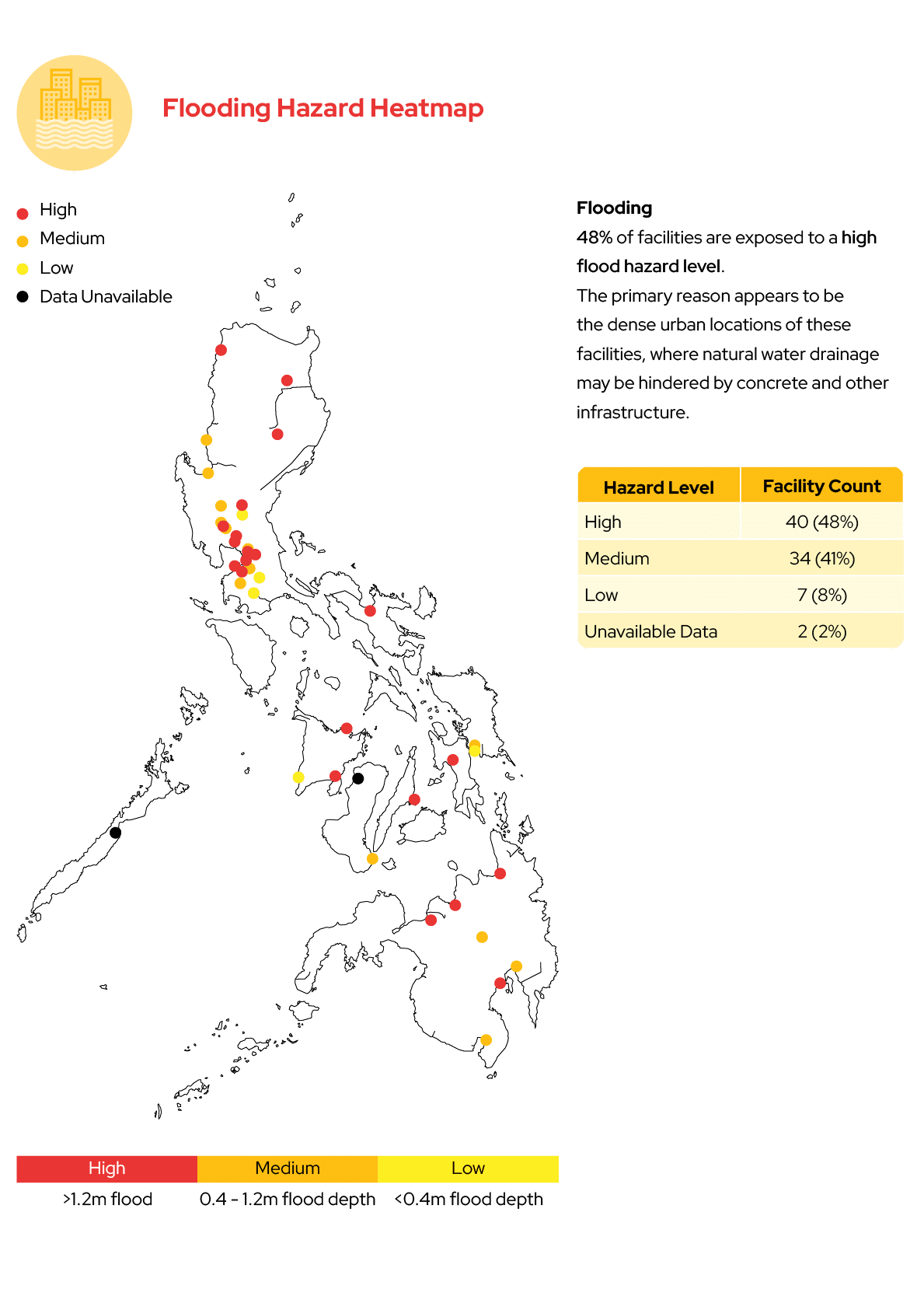
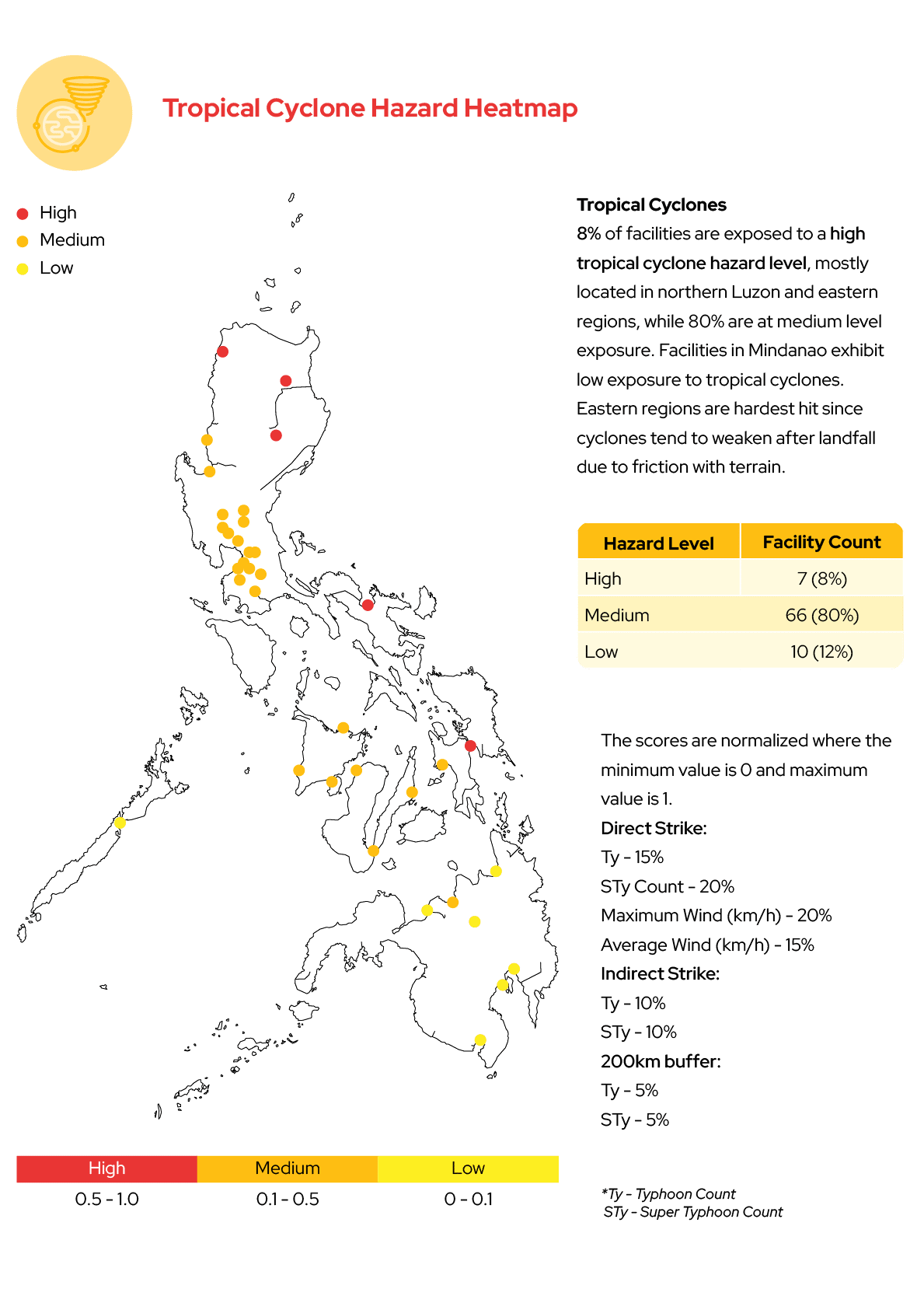
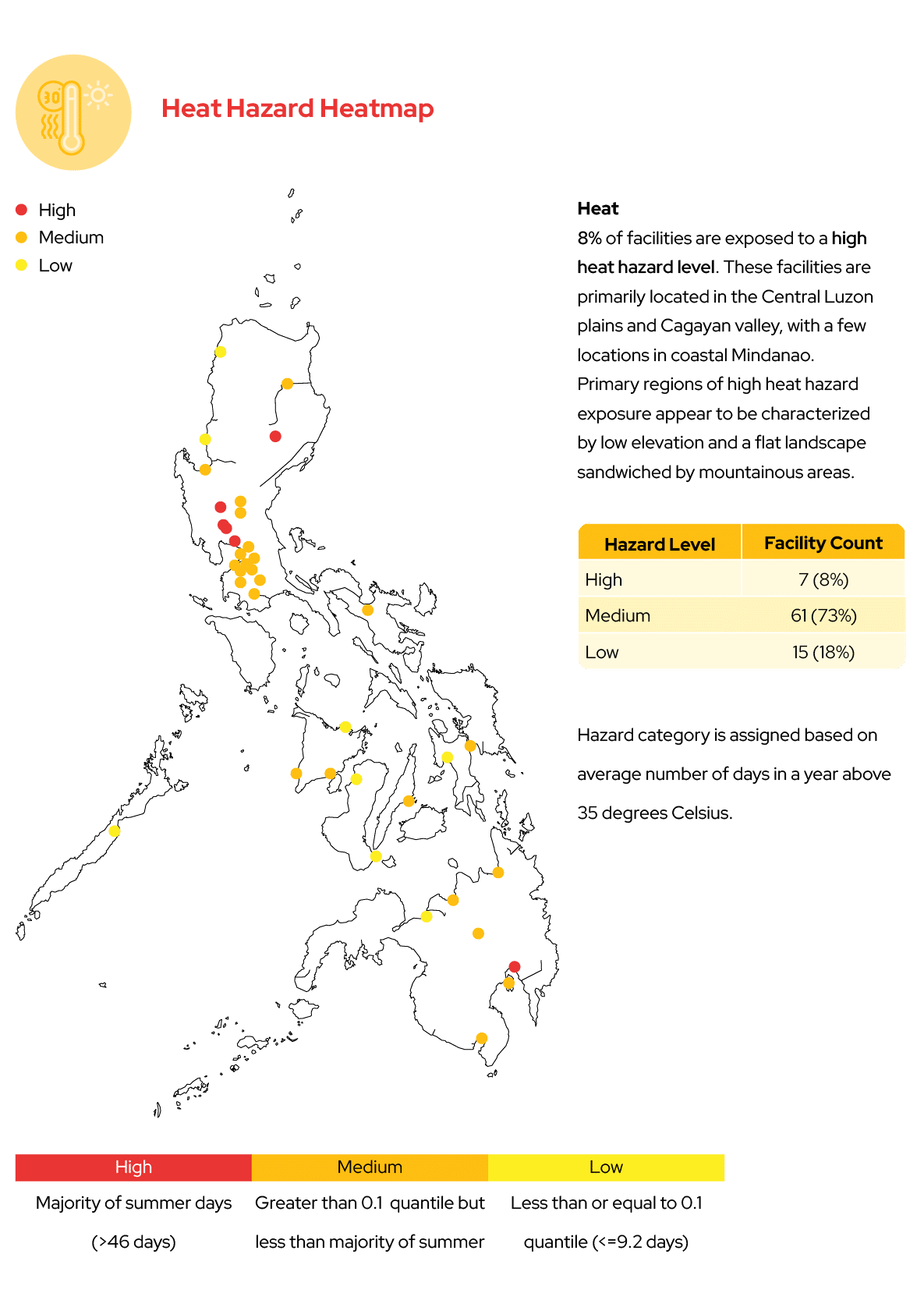
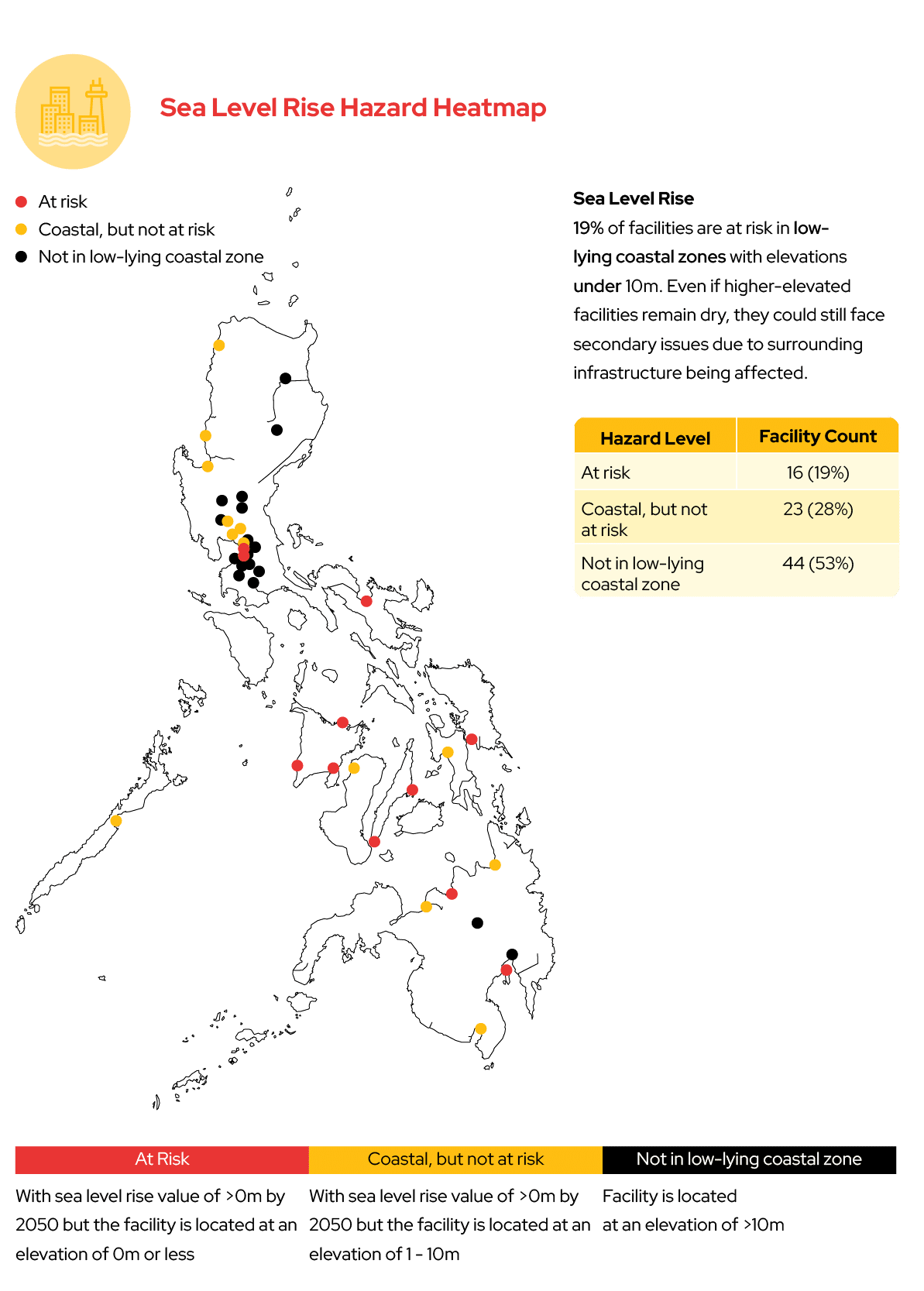
d. Climate vulnerability of the pilot facility
To optimize our climate risk adaptation strategies and
resources, we selected a pilot facility for a detailed
vulnerability assessment. The selection of the pilot facility
prioritized the facility with medium to high climate hazard
exposure, critical importance to our business, and resource
buy-in from the business unit head and facilities managers.
The chosen pilot facility, which is the Sucat Mega
Distribution Center of the Supermarket segment, underwent an
in-depth vulnerability assessment, employing a range of
advanced methodologies. These included:
- Tropical Cyclone Wind Modeling & Structural Analysis: We modeled the potential intensity of tropical cyclones against each facility's wind design threshold. This detailed analysis identified vulnerable areas and helped us quantify potential damage risks.
- Increasing Temperature & Energy Modeling: Rising temperatures were simulated to forecast the impact on energy consumption within each facility, helping us optimize cooling systems and energy management.
- Flood Modeling Assessment: We projected precipitation changes and used hydrological and hydraulic modeling to understand their potential impact on facilities, allowing us to plan flood mitigation measures.
This assessment provides actionable insights for enhancing our
climate resilience. We now have a robust understanding of the
specific vulnerability of the pilot facility and allows us to
tailor risk mitigation strategies, make targeted investments
in structural upgrades, and develop contingency plans. Our
commitment to this data-driven approach ensures that we
protect our assets and ensure business continuity amidst
increasing effects of climate change. The results of this
detailed assessment will be duplicated in the coming years for
other business-critical and highly vulnerable facilities to
climate hazards.
The table below provides an overview of the key climate risks
identified for each facility, along with their potential
financial implications.
Material Climate-related Physical Risks of Sucat Mega DC
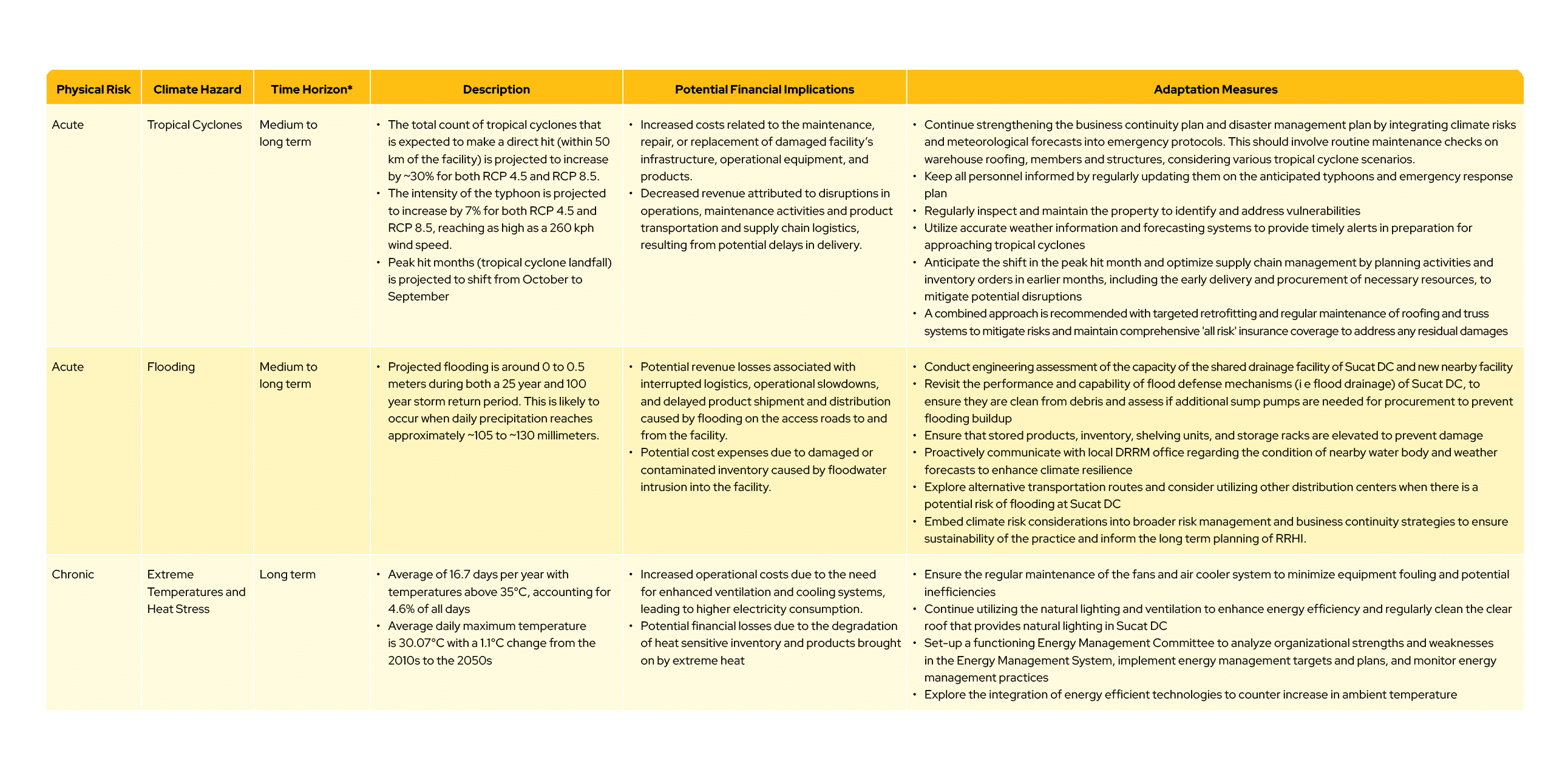
*Short term: 1-5 years (2025-2029), Medium term: 6-15 years (2030-2044), Long term: 16 years and beyond (2045 onwards)
We recognize the importance of transitioning to a lower-carbon economy. The focus of RRHI’s climate related opportunities lies predominantly in addressing physical risks, with a specific emphasis on energy source.
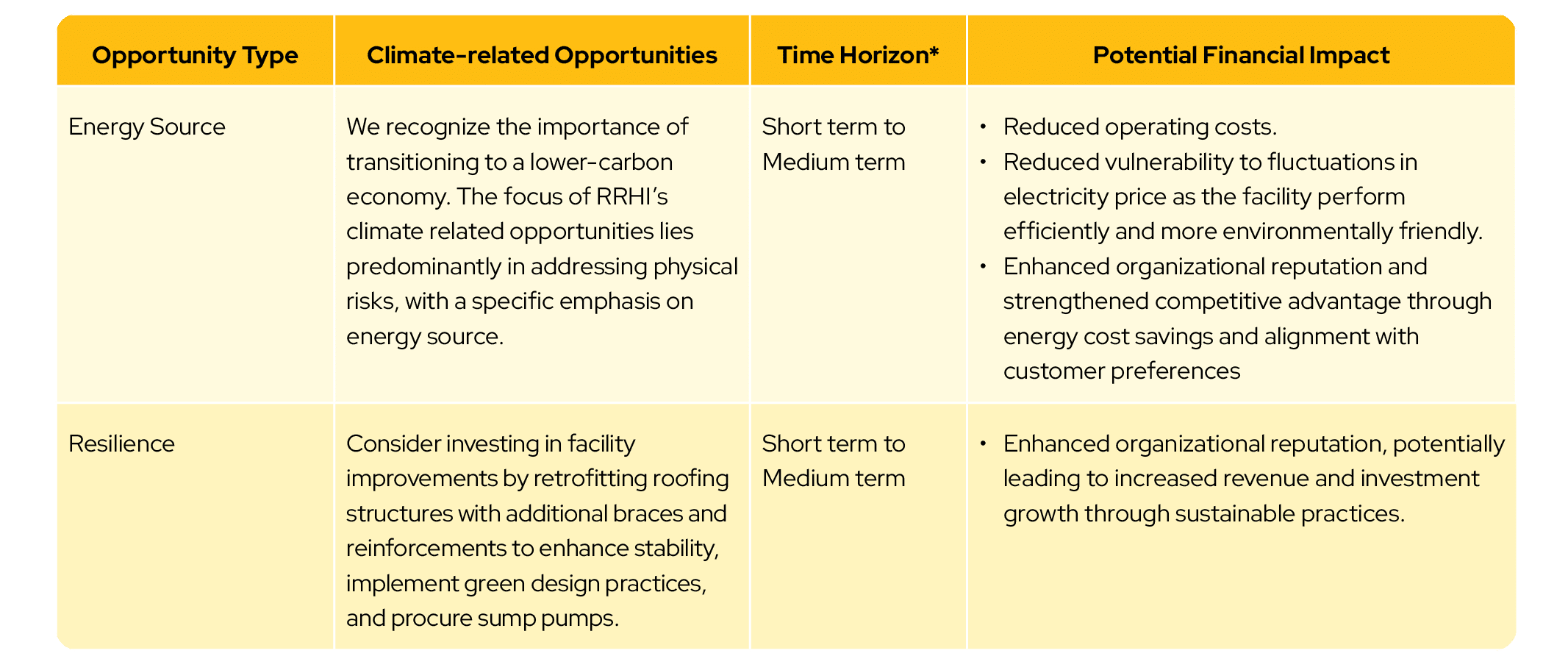
*Short term: 1-5 years (2025-2029), Medium term: 6-15 years (2030-2044), Long term: 16 years and beyond (2045 onwards)
Climate Action and Resilience Strategic Roadmap
Recognizing the dynamic nature of climate science, we commit to regularly evaluate the robustness of our climate strategy. This ensures our operational practices and investments align with sustainability and climate resilience goals. Within 2025 to 2030, we plan to release our low-carbon transition roadmap that includes the result of transition risks assessment. This proactive approach will help us mitigate risks while also identifying new prospects within the growing climate-resilient marketplace. Through proactive risk management and strategic foresight, we strive to ensure the long-term resilience and sustainability of our operations and the broader value chain.
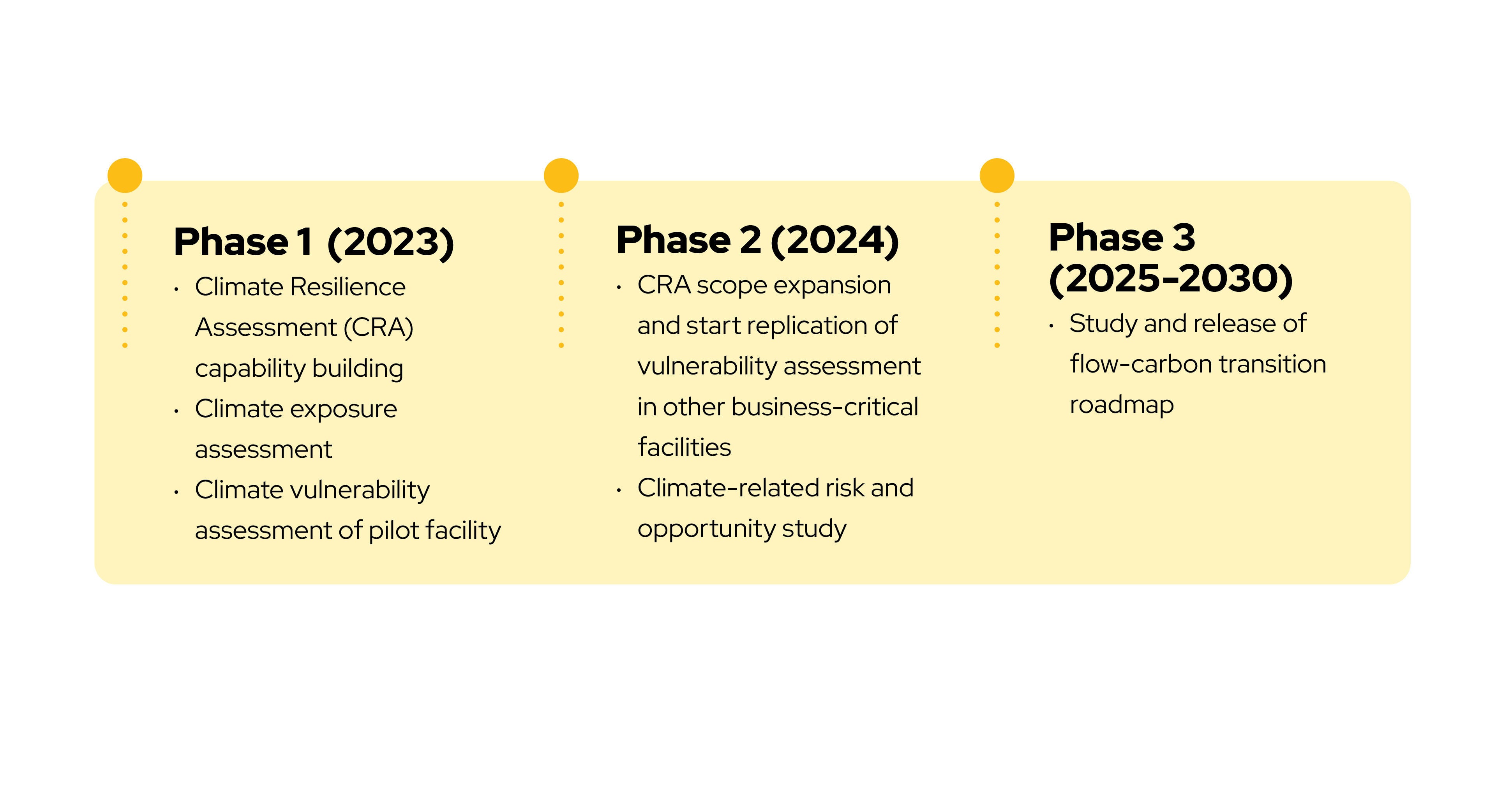
The timeline focuses on assessing climate risks, integrating climate resilience into business practices, and developing a low-carbon transition roadmap.

Solid Waste Management
We continue to implement effective waste management through
segregation measures. We aim to streamline our processes by
implementing standardized practices across all banners,
ensuring consistency and efficiency in handling solid waste.
To bolster our efforts, we are dedicated to systematizing the
collection and analysis of solid waste generation data. By
establishing a comprehensive data-gathering system, we gain
valuable insights that will inform our waste recycling and
diversion targets. This strategic approach empowers us to
optimize our waste management practices and minimize
environmental impact.
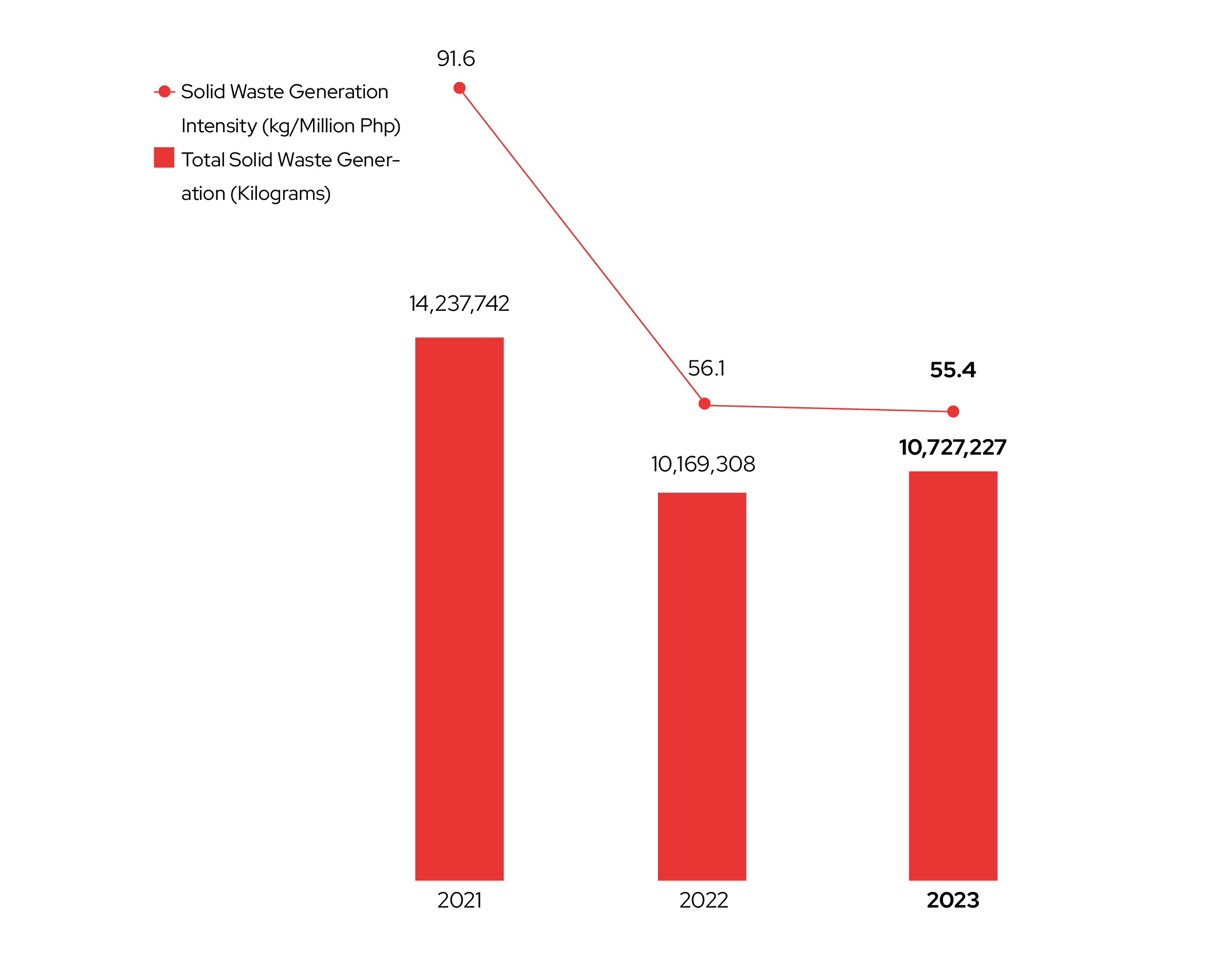
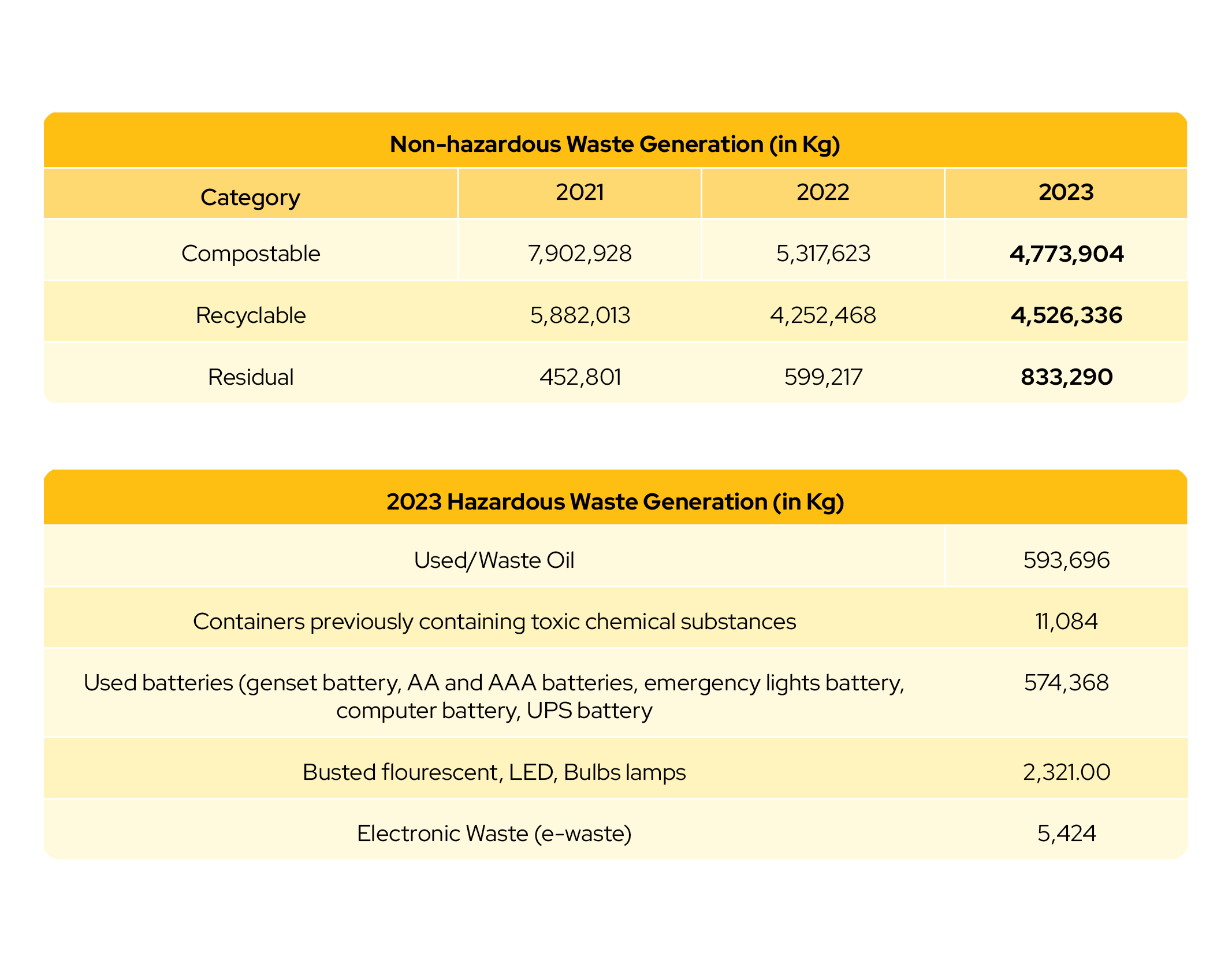

Materials Consumption
We are dedicated to responsible usage of plastic for consumer
packaging across our operations. Our strategy involves
continuous monitoring of plastic consumption, enabling us to
track usage patterns and identify areas for improvement. By
implementing proactive measures, we strive to steadily reduce
our resilience to plastic materials while ensuring the
sustainability of our packaging practices.
In 2023, we achieved a 51% decrease in non-renewable materials
consumption intensity. This reduction reflects our dedication
to minimizing our environmental footprint and transitioning
towards more sustainable practices.
We have identified opportunities to optimize resource
utilization across our operations. By implementing innovative
solutions and embracing alternative materials, we have been
able to streamline our processes while simultaneously reducing
our reliance on non-renewable resources.
